The
soundscape composition is a form of electroacoustic music,
developed at Simon Fraser University and elsewhere,
characterized by the presence of recognizable environmental
sounds and contexts, the purpose being to invoke the
listener's experience, associations, memories and imagination
related to the soundscape.
It grew naturally out of the pedagogical intent of the World
Soundscape Project (WSP) to foster soundscape awareness.
At first, the simple exercise of 'framing' environmental sound
by taking it out of context, where often it is ignored, and
directing the listener's attention to it in a publication,
broadcast or public presentation, meant that the compositional
technique involved was minimal, involving only selection,
transparent editing, and unobtrusive cross-fading.
This 'neutral' use of the material established one end of the
continuum occupied by soundscape compositions, namely those
that are the closest to the original environment, or what
might be called phonography or "found compositions".
Other works use transformations of environmental sounds and
here the full range of analog and digital studio techniques
comes into play, with an inevitable increase in the level of
abstraction. However, it is typical that the resulting sounds
are abstracted from the original, that is, by
retaining an aural or psychological relationship, and do not
become entirely abstract.
However, the intent of transformation is always to reveal a
deeper level of signification inherent within the sound and to
invoke the listener's semantic associations without
obliterating the sound's recognizability.
We will
present these categories as follows, with compositional
examples selected from WSP members including Hildegard Westerkamp
who has specialized in this genre, along with those by
composers who have been published by Cambridge
Street Records. However, we encourage you to listen to
works by the wide range of composers and environmental sound
artists working in the area worldwide.
A) A continuum of approaches
B) Fixed spatial perspective
C) Moving spatial perspective
D) Abstracted spatial perspective
E) Detailed analysis of specific soundscape
compositions
home
A.
A continuum of approaches. In a rapidly evolving field
that can be loosely grouped together as soundscape
composition, it can be expected that there is a wide range of
approaches. One way (and not the only one) to get an overview
of this range is to place it on the following continuum where
the approach mentioned above, phonography (by analogy
to photography) is placed in the middle.
The phonographic approach is rooted in Field Recording where the
intent is to document a particular place and its soundscape,
or at least certain aspects of it. There is minimal
transformation, and any editing or mixing is done transparently,
meaning that these manipulations do not attract particular
attention.
On the other hand, there are subjective choices being made at
every stage of the work – which are quite clearly demonstrated
in the Field Recording module with many of their dimensions –
and the field recordist never regards the material as
"objective" or "neutral". In that sense, the final result can
be regarded as a composition that can be listened to as if
it were music, that is, with the same attention one can give
to music (assuming it's not just background sound).
Given this concept of phonography, we can place it in the
middle of this continuum:
Sonification/Audification
<----------------> Phonography
<----------------> Virtual Soundscapes
mapping the
real
found
sound
abstracted sound
Sonification
refers to a range of approaches that map real-world
data onto sound parameters, sometimes termed auditory
display. Closely related is audification that
translates the data directly into sound, i.e. as a waveform,
though there are usually tricky issues of the time scale being
at audio rates, or needing to be transposed in some way to
accommodate human hearing.
Applications of sonification range from artistic projects
driven by scientific data in installations, sculptures, fixed
media works and concert pieces, such as the EcoSono projects
by Matthew Burtner, to those where artistically informed
design strategies are used to communicate scientific data to
the public. Today many such projects are driven by
environmental concerns, such as the work of Andrea Polli.
This range of approaches can be regarded as extending from
“science in the service of art” to its reversal as “art in the
service of science”. This distinction adds some clarity to the
more general term “environmental art” where the
question arises as to whether the environment merely serves
the artist (as material or context), or whether the art can
actually benefit the environment and public perception in some
way.
Phonographic approaches, as in the middle
of the continuum, are often based in environmental bioacoustics
or the practice of sonic ethnography with its social
and cultural focus. One of its main proponents, John Drever,
raises provocative questions about representation (of
what, how and for whom?) which are typical of contemporary
ethnographic practice – sonic tourism vs. a more involved
approach – that we raised in the Field Recording module. In
other words, are we creating just another illusion of
“fidelity”?
For instance, Gregg Wagstaff’s TESE (Touring Exhibition of
Sound Environments) field projects have incorporated community
involvement in recording and assembling a phonographic
style documentary of their community. Other sound artists
working in this vein spend a lot of time doing research and
actually living in a community while they are field recording.
They may also present their own audio representation back to
the community for approval.
The right side of the continuum, from phonography to what
we’re generalizing as “virtual soundscapes” with increasing
abstractedness, is what we will cover in this module. What we
can only refer to is the contemporary use of multi-channel
speaker rigs (often in multiples of eight channels in a
surround-sound configuration) that can provide a sense of
complete immersion in a virtual soundscape, including height.
However, many of the stereo examples we present here may
suggest that direction.
To summarize the general characteristics
of soundscape composition, here is an often quoted list:
- Listener
recognizability of the source material is maintained
- Listener's
knowledge of the environmental and psychological
context is invoked
- Composer's
knowledge of the environmental and psychological
context influences the shape of the composition at
every level
- The work enhances
our understanding of the world and its influence
carries over into everyday perceptual habits
Once you
start working with sound recordings and apply some of the
transformation techniques as covered in the Tutorial, you
realize that the recognizability of the sound object
can quickly be lost, or at least obscured. In many cases,
that doesn’t matter because the compositional intent is not
about the sound object in any semantic sense, but
rather it is about the sound as sound for its own sake.
The style of composition that results from this approach is
called acousmatic, which refers to sound where the
source is unseen, but to give it less of a definition of
absence, the sound itself is regarded as sufficient to carry
meaning. The formal practice of acousmatic music puts an
emphasis on the spectromorphology of sound,
literally “sound shapes”, as manifest through the timbre and
textures of sound, discussed in the second Vibration module
Therefore, the acousmatic approach moves sound towards an abstract
dimension where contextual references can be minimized.
Soundscape composition, on the other hand, wants to
integrate the sound source and the listener’s contextual
knowledge into the composition, and hence some degree of
recognizability is maintained, as outlined in the first two
points above. Listeners also may react by saying they
“participate” more while listening because of the
recognizability of the sounds they hear and what they evoke.
The third point about the composer’s knowledge influencing
the composition at every level is actually more challenging
in some ways. It’s certainly not the way instrumental music
is taught in the Western classical tradition, where a
similar degree of abstraction (as in acousmatic music) is
assumed and preferred. In fact, music with too much
real-world reference is termed “program music” and is
generally given less importance.
Soundscape composition, on the other hand, intends to bring
the complexity of the real-world (including the inner world
of memory, affect and symbolism) to bear on the
compositional result. Probably the best way to describe this
subtle process will be through the sound examples in the
rest of this module.
To put it even more simply: the soundscape composition is about
something in the real world, and listeners are invited to participate
more in listening.
The final point above about changing our perception and
understanding of the world can be traced to the idealism of
the young composer researchers working in the World
Soundscape Project in the 1970s, but the current concerns
for environmental issues have certainly re-kindled some of
that optimism and desire for making a contribution.
Whether or not soundscape composition (or any other
environmental art form, for that matter) will have any
lasting effects remains to be seen, but once you engage with
it as a recordist and sound designer, it is inevitable your
experience will carry over into everyday life. Your ears
will be tuned differently.
Moving beyond soundscape composition.
The notion of soundscape as how a sonic environment is
perceived and understood is generally associated with a
concept of place and the creation of acoustic space. A more
general umbrella term could be context-based composition
where the approach as outlined above opens up the references
to any real-world context and utilizes the entire
range of approaches outlined above. The intent is to be more
inclusive and to think about how we can use sound
effectively to address any other issue – essentially to
argue with and through sound.
Index
B. Fixed spatial perspective. There
are various structural types found in soundscape
compositions that derive from soundwalks, sound
monitoring, and field recording practice. The first of
these we will consider is characterized by a fixed spatial
perspective, similar to the exercise of sitting in one
place and monitoring all of the sounds one hears – a
useful exercise on any occasion, and one is often
surprised by what actually happens.
This basic perspective emphasizes the flow of time,
or else it can be a discrete series of fixed perspectives
possibly linked by smooth edits or cross-fades. Media
experience seems to result in listeners being quite
tolerant of simple transitions such as this without being
disoriented by the replacement of one soundscape by
another.
Variants on this format include time compression
(where the time flow is foreshortened by leaving out parts
of it, not a compression of the sound itself), as well as
those involving narrative or oral history
accounts that do not involve a soundwalk.
Again, the foreshortening of time seems quite
natural, not only because of media practice, but because
human memory does something quite similar. Recordists
notice this when they listen to a long take of events
they've recorded, and realize that those events now seem
to actually “take longer” than the way one remembers them.
We probably just remember the highlights, so to speak.
Memory is clearly not correlated well with clock time.
Since a soundscape is defined and treated as the perceived
sonic environment, then time compression and
foreshortening techniques may actually make the edited
recording seem more realistic, at least within certain
limits.
Layering in stereo or 8 channels.
We heard this first example in another module as a demonstration
of “soundscape fusion”, where four stereo recordings, all
done around Vancouver harbour, were mixed together as a
single fixed-perspective document in stereo. Although
there might be logical inconsistencies, most listeners
would accept this as a plausible phonographic
representation of the harbour, something that could
have happened this way.
But of course it didn’t. In the complete recording, done
for the 1996 Soundscape Vancouver double CD, the
intent was to produce a 4-minute recording of the harbour
that could be compared with a 1973 version on the other
CD, and the result was achieved by mixing four tracks
together.
However, if we had to forego any mixing or editing, that
would constrain us to a few minutes before and after noon
when the O Canada horn sounds daily. We would likely miss
other typical events that didn’t occur within this
restricted time frame, and hence our representation of the
harbour would be less inclusive.
Vancouver harbour mix
from Soundscape Vancouver 1996, CSR-2CD 9701
Reminder: if you want to follow along with
the enlarged spectrogram, use a Command
click on the image after you begin
the audio to open it in a new tab
|

Click to enlarge
|
Since we clearly had to choose which events to include,
and which not, the question arose as to “how many
seaplanes?”. The context here is that seaplane noise is an
issue for local residents living near the harbour. As
well, the harbour has the beautiful backdrop of the
coastal mountain range which is often snow-capped. The
physical environment is “picture postcard perfect” and
often used to attract tourists.
So, maybe if we were contracted by the local Tourism
Office, they might not want us to include any
seaplanes, and no doubt most listeners wouldn’t notice or
object to their absence. On the other hand, if we wanted
to “make a point” about seaplane noise, we could add a
huge number in order for listeners to get the message. So
how do we decide how to proceed?
A simple solution if we want to be
representative is to do a soundwalk in the area
first and make a count of the seaplanes we hear. This is
also a good idea for discovering what else to incorporate
into the mix that would be typical. As it turned out,
three seaplanes were added to the four-minute mix, as well
as number of boathorns and ending with the O Canada horn.
A similar approach was taken in my Pendlerdrøm
work from 1996, commissioned by a Danish group on the
theme of commuting, pendler being a commuter and drøm
being a dream. I was given one hour of excellent quality
recordings taken from the busy Central Station
environment, including the local commuter train that the
recordist rode on to get there. The commission was for a
stereo piece, but I had a digital 8-track Tascam playback
machine which could be mixed to stereo or 8-channel, so
both versions became possible.
In the opening excerpt presented here, it was easy to
simulate the immersive environment of the station by
simply taking four original stereo tracks and
multi-tracking them, as shown below in the first
production page. For the first 40” there are just two
stereo tracks, before they are joined by two more, so the
density builds up. These tracks were from sequential
recordings, but together they fuse easily and suggest a
situation that was admittedly slightly busier, though not
atypically, than the actual station at the time.
Production score, beginning of Pendlerdrøm
(1996), Copenhagen train station sound files
All of the tracks are kept separate in the
8-channel format, except for tracks 3&4 which, being
mainly the public address announcements, could logically be
coming from multiple speakers. Normally for 8-channel work, it
works best to put stereo pairs in adjacent channels (ignore
the unusual numbering scheme in the diagram that was in use at
the time for our speakers). For the stereo mixdown,
speakers on the left go to the left channel of the mix, and
speakers on the right go to the right channel, and middle
speakers are panned to the middle, in case you’re interested.
We will return to the piece in the next section for an example
of moving perspective.
Opening
of Pendlerdrøm, simulating the busy train
station in Copenhagen,
from Islands, CSR-CD 0101
|
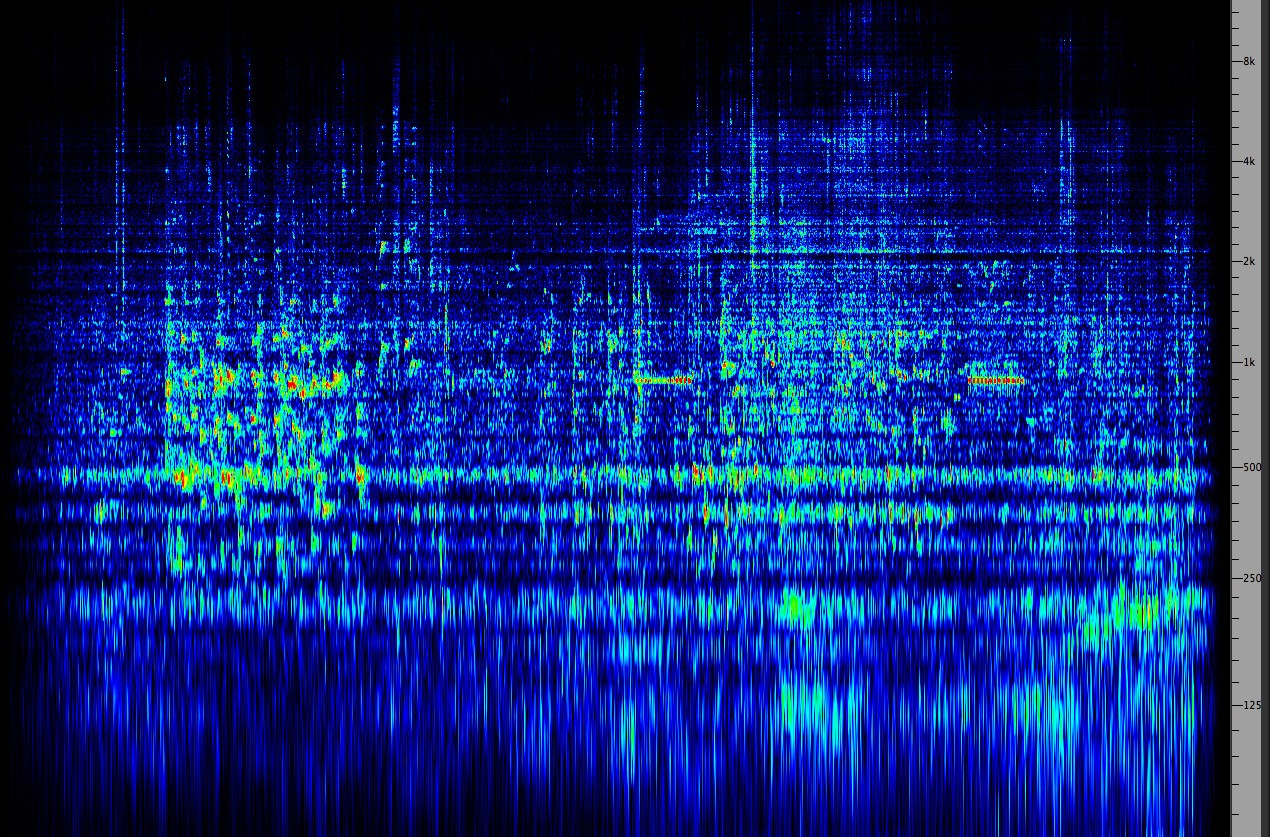
Click
to enlarge
|
The next
example from another 8-channel work Island (2000)
takes this approach a step further by multi-tracking and
mixing realistic and transformed materials. In fact, for the
8-track version, there are 8 tracks of short soundfiles of
individual waves on a beach, and 8 tracks of transformations
of them.
Here is the opening production score for the realistic sounds,
that arranges 5 different individual waves around the space
(N, S, E & W), plus two more of wave ambience as a
background. This pattern of waves repeats after 1 minute
(which you’ll probably only notice now that it has been
pointed out). The only processing is that there is a slight
exaggeration of the crest of the wave breaking clockwise to
the right which has been expanded by 90° to make it seem
broader.
Production score, beginning of Island
(2000), realistic sound files
Next we have the 8 transformed tracks, the
first four being high-pass filtered so that just the very
brightest component of these small wavelets is heard. These
sounds are also resonated with a Karplus-Strong
resonator with strong feedback. Tracks 3&4 are
transposed downwards by a fifth. The other four tracks are
low-pass filtered with the same resonator, but at a low
resonant pitch with maximum feedback to create a drone.
This drone at first seems out of place in a seaside soundscape
– the intent being to add an air of mystery to this imaginary
island – but in fact the same waves are triggering the rise
and fall of the feedback creating the drone.
 Production
score, beginning of Island (2000), transformed sound
files
Production
score, beginning of Island (2000), transformed sound
files
Opening
of Island (2000)
from Islands, CSR-CD 0101
|
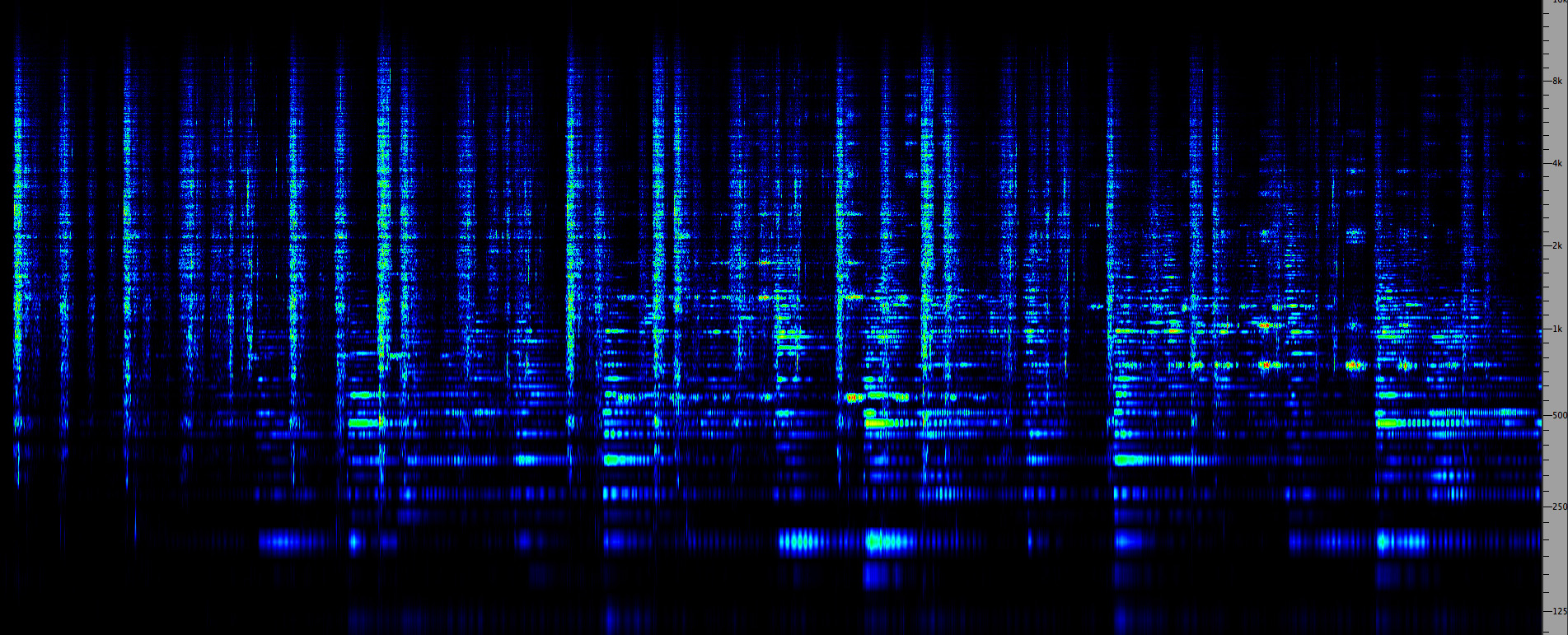
Click
to enlarge
|
The initial “attack” of the event, after a tentative start, is
a large ferry docked near the recordist, after which many
other boats join into a “steady state”, followed by a very
long “decay” as the participants drift away. This excerpt is
just the first few minutes of the entire sonic event.
New Year's
Eve, Vancouver harbour, 1980-81,
from Soundscape Vancouver 1996, CSR-2CD
9701
|
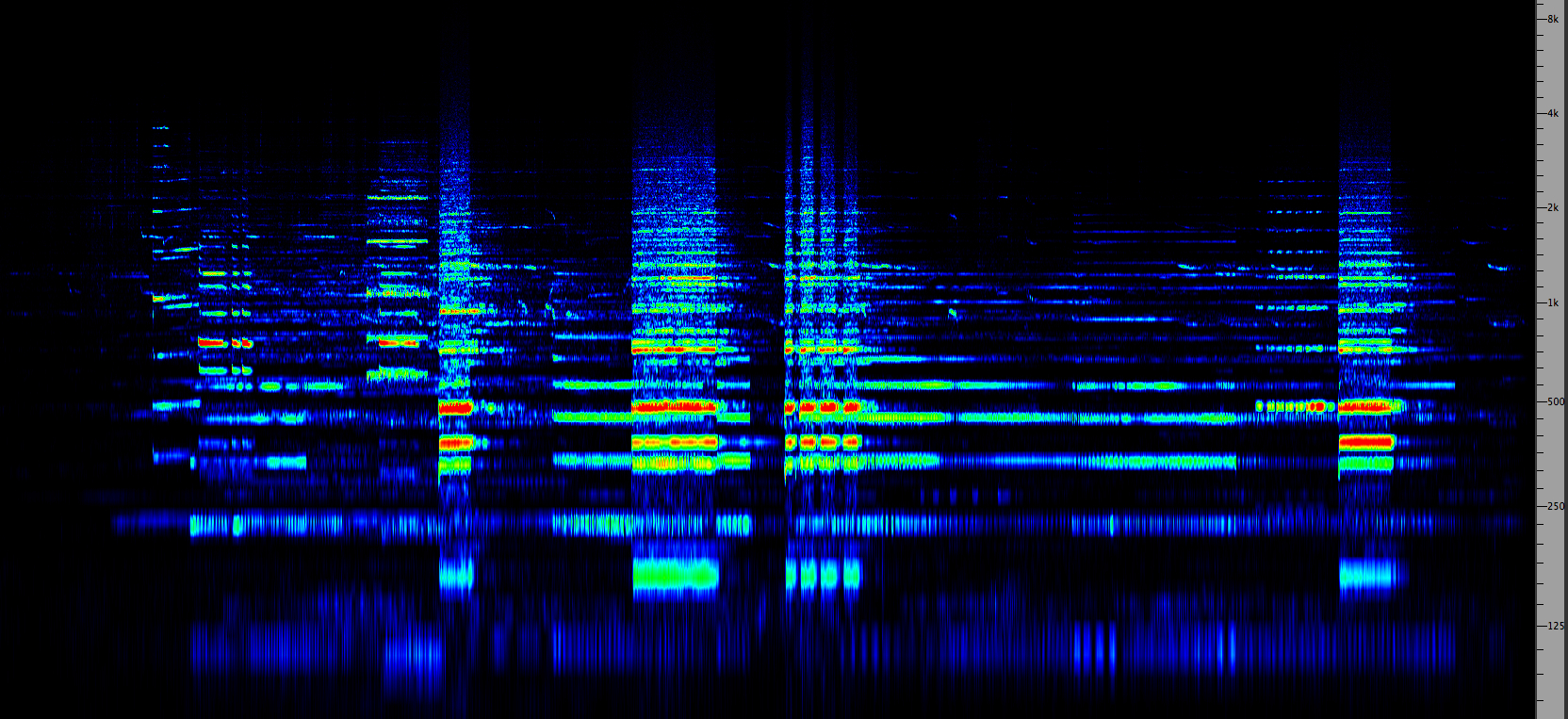
Click
to enlarge |
The
WSP's 24-hour “Summer Solstice” recordings in June 1974, were
done on the rural grounds of Westminster Abbey near Mission,
BC, where the birds and frogs around a pond formed an
ecological micro-environment. An edited version of these
recordings consisting of about 2 minutes per original hour was
broadcast on CBC Radio in stereo as part of the radio series Soundscapes
of Canada in October 1974.
The time compression for each “hour” was achieved with
transparent editing, with a short verbal announcement of the
time being the only commentary. Therefore, over the course of
the hour-long program, a listener could experience the
soundscape of an entire day at this site, something that would
be physically impossible for an individual to do.
Summer
Solstice recording 3 to 8 am, June 1974
from Soundscapes of Canada
|

Spectrogram
of the period just before and after dawn (3:30 am)
showing frequency niches for frogs and birds
(click to enlarge)
|
Narrative, poetry and oral history.
These different types of verbal practices can be integrated
into a fixed spatial perspective and provide their own
rhythmic pulse.
We begin with Hildegard Westerkamp’s 1979 extension of her Whisper
Study that incorporates her reading a poem by Norbert
Ruebsaat “When there is no sound”, written in response to the
earlier version of her piece. The poem is matched to the sound
of icicles and footsteps in snow that originally appeared on
Hildegard’s radio program Soundwalking on Vancouver
Co-op Radio. Each element complements the other perfectly.
Excerpt
of Hildegard Westerkamp's Whisper Study (1979)
with a poem by Norbert Ruebsaat
from SFU-40, CSR-CD 0501 |
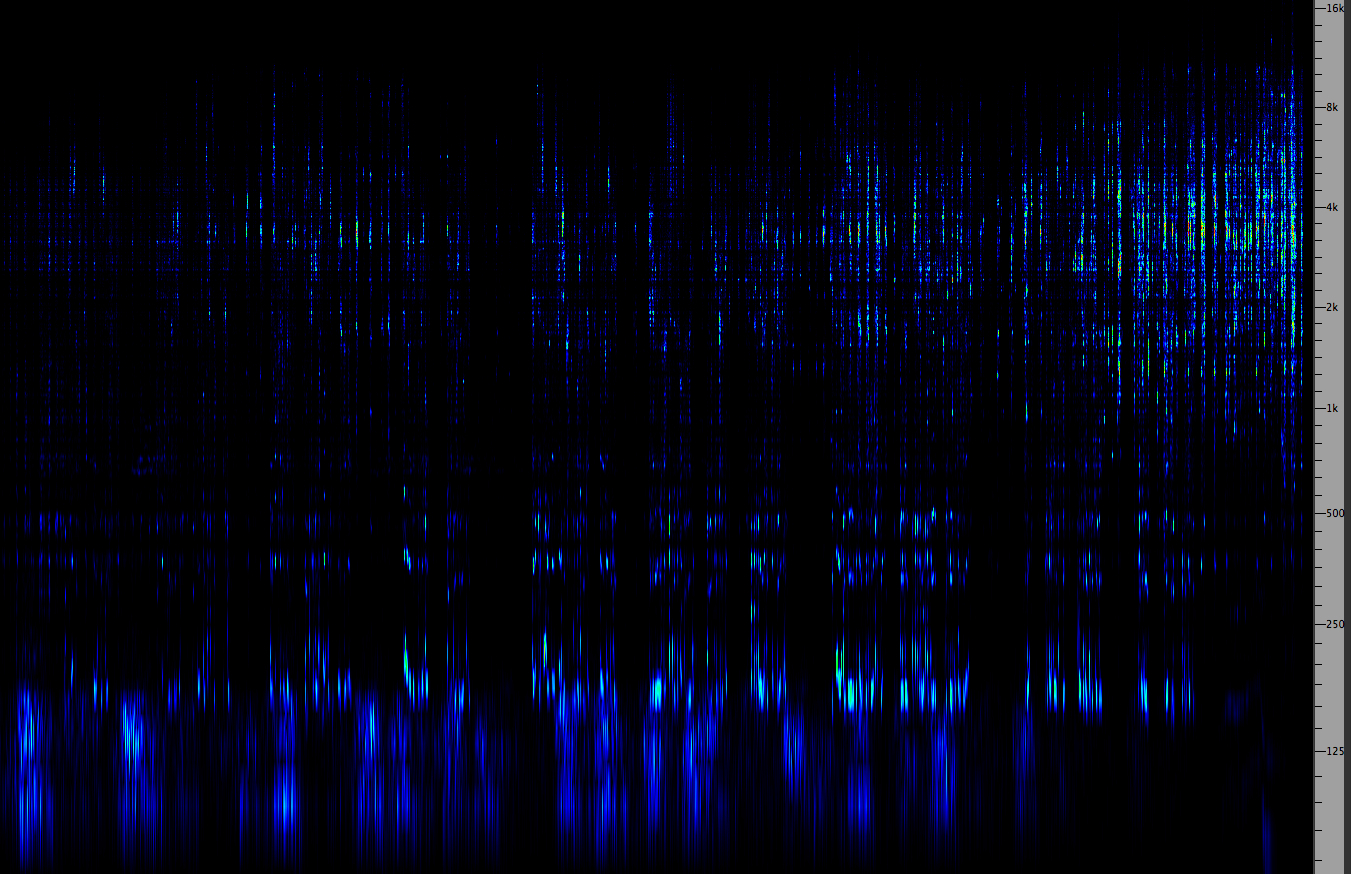
Click
to enlarge
|
My 8-channel
work Prospero’s Voyage (2004) imagines Prospero about
to leave his island, at the end of Shakespeare’s last play The
Tempest. The actor Christopher Gaze intones Prospero’s
last speech of the play as he addresses the audience,
beseeching them to “set me free”.
The soundscape is that of a storm (in the play, Prospero has
been able to command the elements) which at the end of the
speech breaks into a heavy downpour that pounds the roof and
is intended to sound like applause. However, note that the
actor’s voice has been placed into the reverberant space of an
actual theatre whereas the soundscape is clearly outdoors.
Does that inconsistency actually work?
Opening
of
Prospero's Voyage (2004)
with actor Christopher Gaze
from Spirit Journies, CSR-CD 1401
|
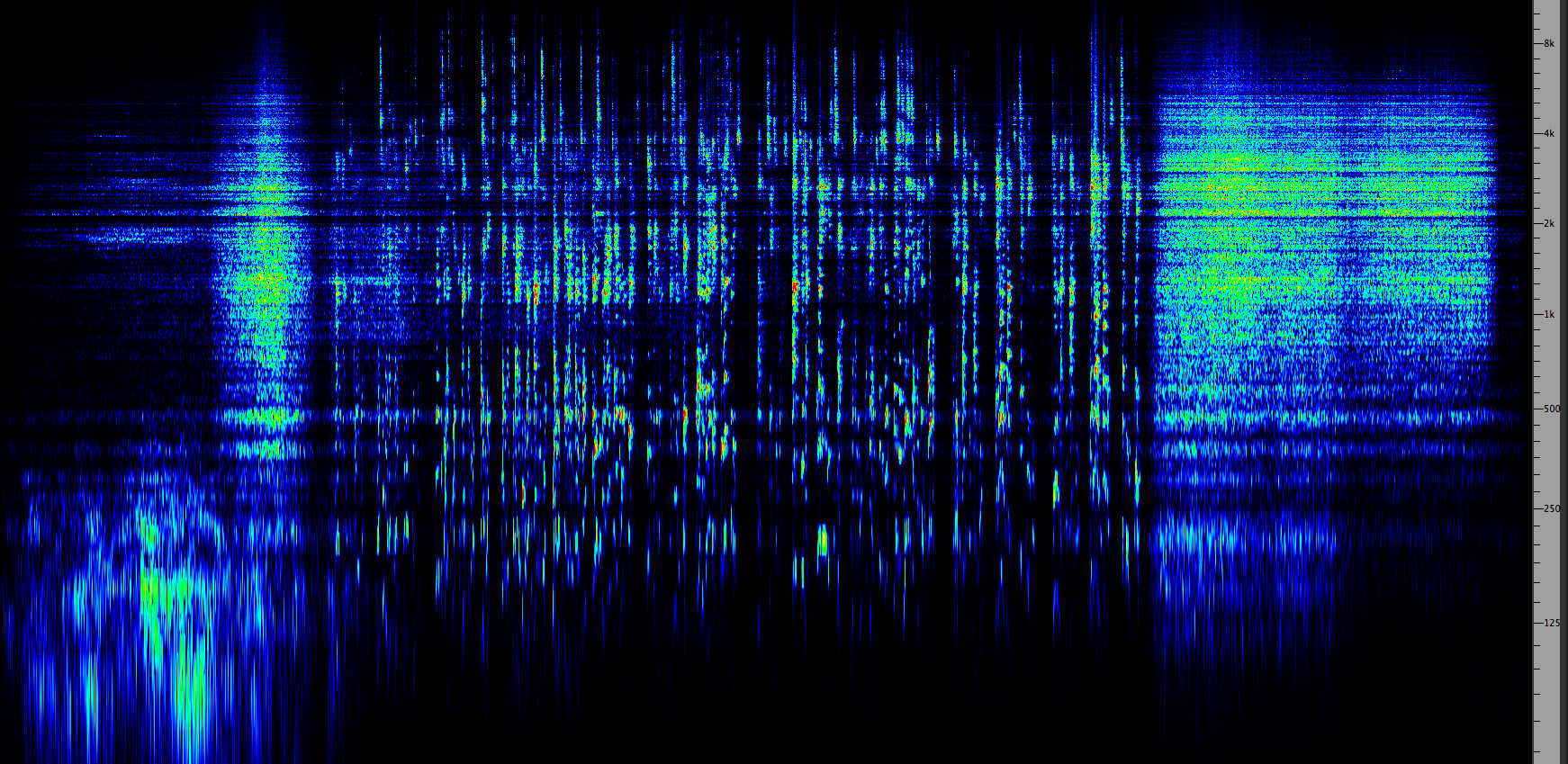
Click
to enlarge |
Bruce
Davis’ Bells of Percé was part of the Soundscape
of Canada broadcast in 1974 and is based on recordings
he (and Peter Huse) made in Percé, Québec, of the local
churchbells along with an oral history interview with
the parish priest.
This very poetic opening sequence filters the bells into a
cloud of partials through which we hear brief excerpts of the
priest’s stories about the bells, their names, and legends
associated with the region. The technique of foreshadowing the
main body of the piece with brief glimpses of the main
narrative sets the mood for the piece and suggests some of the
history, imagery and symbolism that is to come.
Opening
of Bruce Davis' Bells of Percé (1974)
from Soundscapes of Canada
|
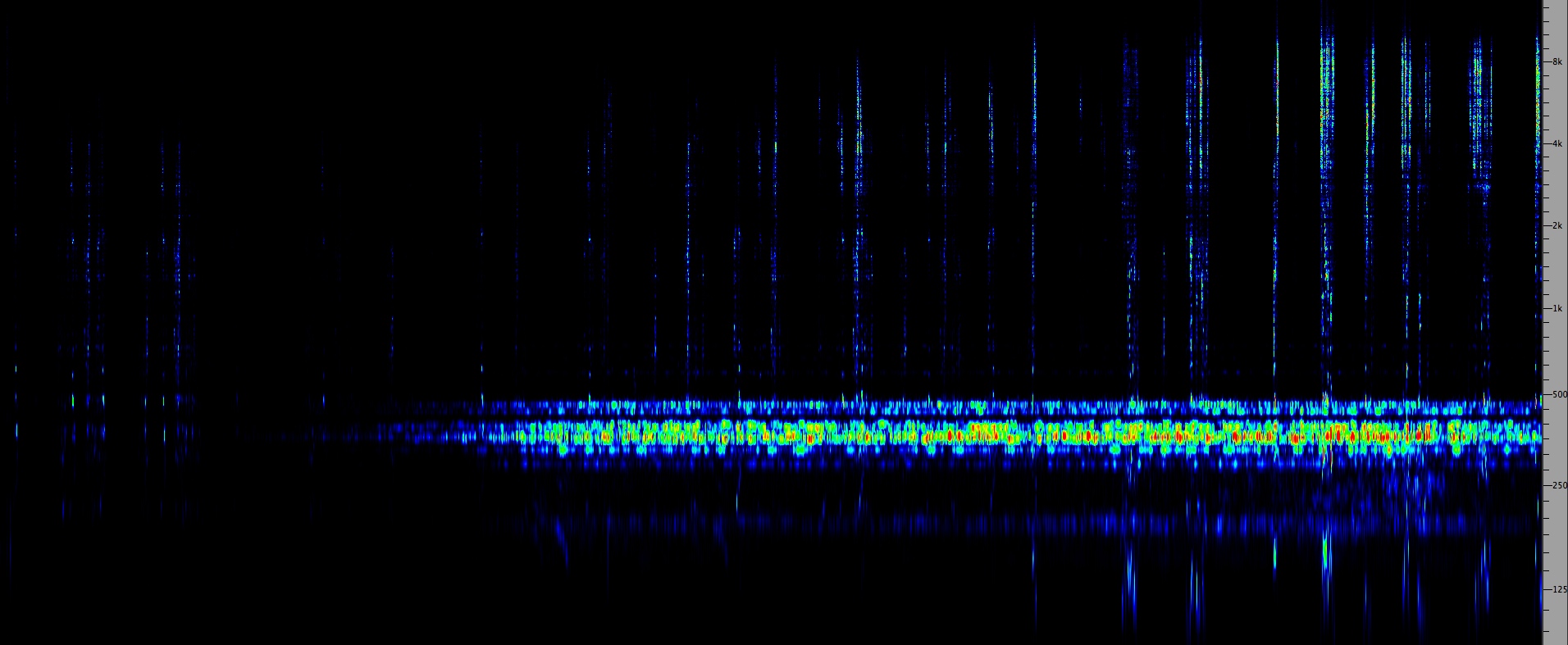
Click
to enlarge |
Transitions between fixed perspectives.
As mentioned above, transitions in the context of an otherwise
fixed spatial perspective do not have to be “logical” in
either the time frame or how one has actually moved from one
soundscape to another. However, they shouldn’t sound too
awkward or abrupt either, unless a violent contrast is somehow
desirable.
In Hildegard Westerkamp’s Talking Rain (1997), the
opening section includes several rainy ambiences, all of which
have a different density and character. However, she avoids
the more usual technique of the smooth cross-fade to go from
one to the other. For one thing, it is easy to habituate to
the sound of rain and a cross-fade might only suggest a change
in its character, not a change in location.
Her solution, used twice, at first seems irrational because
the transition is signalled by a brief sound of a car passing
on a rainy pavement – a very urban type of sound (whereas the
other sounds of rain appear to be in a forest). However, each
transition works at the immediate level of drawing attention
to the change and making one more aware of the gentler texture
and lesser density of the ambience being introduced. On a
larger level of the entire piece, she is later going to make a
sudden transition to a noisy downtown rain-soaked street in
the middle of the piece, so these transitions foreshadow that
contrast.
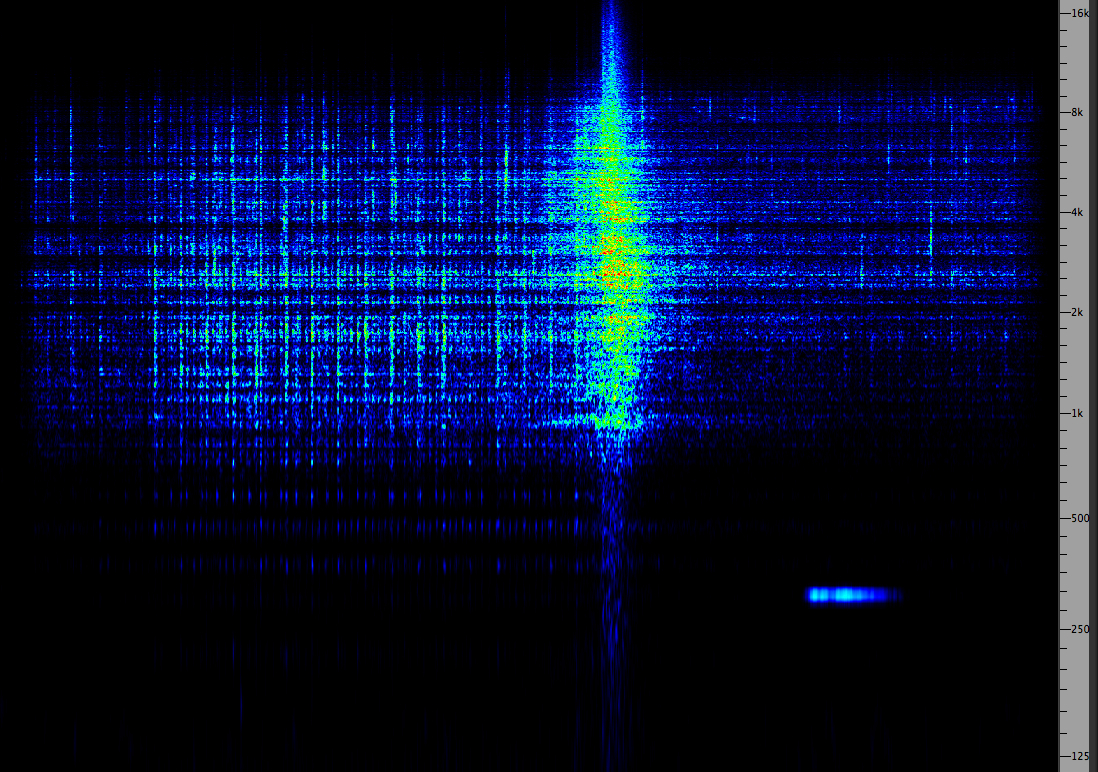
Click
to enlarge either image
|
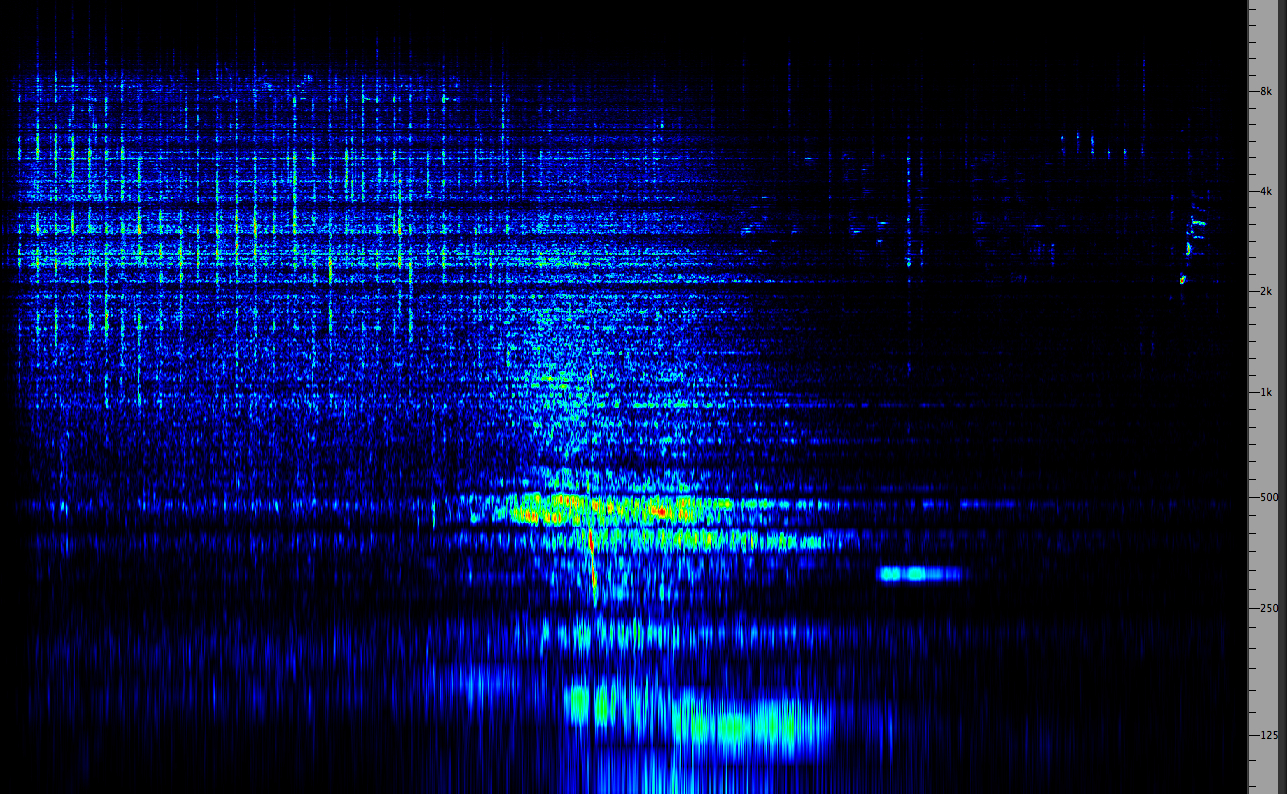
Two transitions from Hildegard Westerkamp's Talking
Rain (1997),
Earsay CD
|
Westerkamp
uses another type of foreshadowing to open her work Beneath
the Forest Floor (1992) where individual sounds and
gestures are introduced individually over a mysterious and
obviously transformed “thumping” sound, thereby creating a
suspenseful sense of anticipation while evoking a West Coast
rainforest. The unifying thumping sound keeps the perspective
fixed, but the brief encounters with other events suggest
transitions in time or memory.
Opening
of Hildegard Westerkamp's Beneath the Forest
Floor (1992)
|
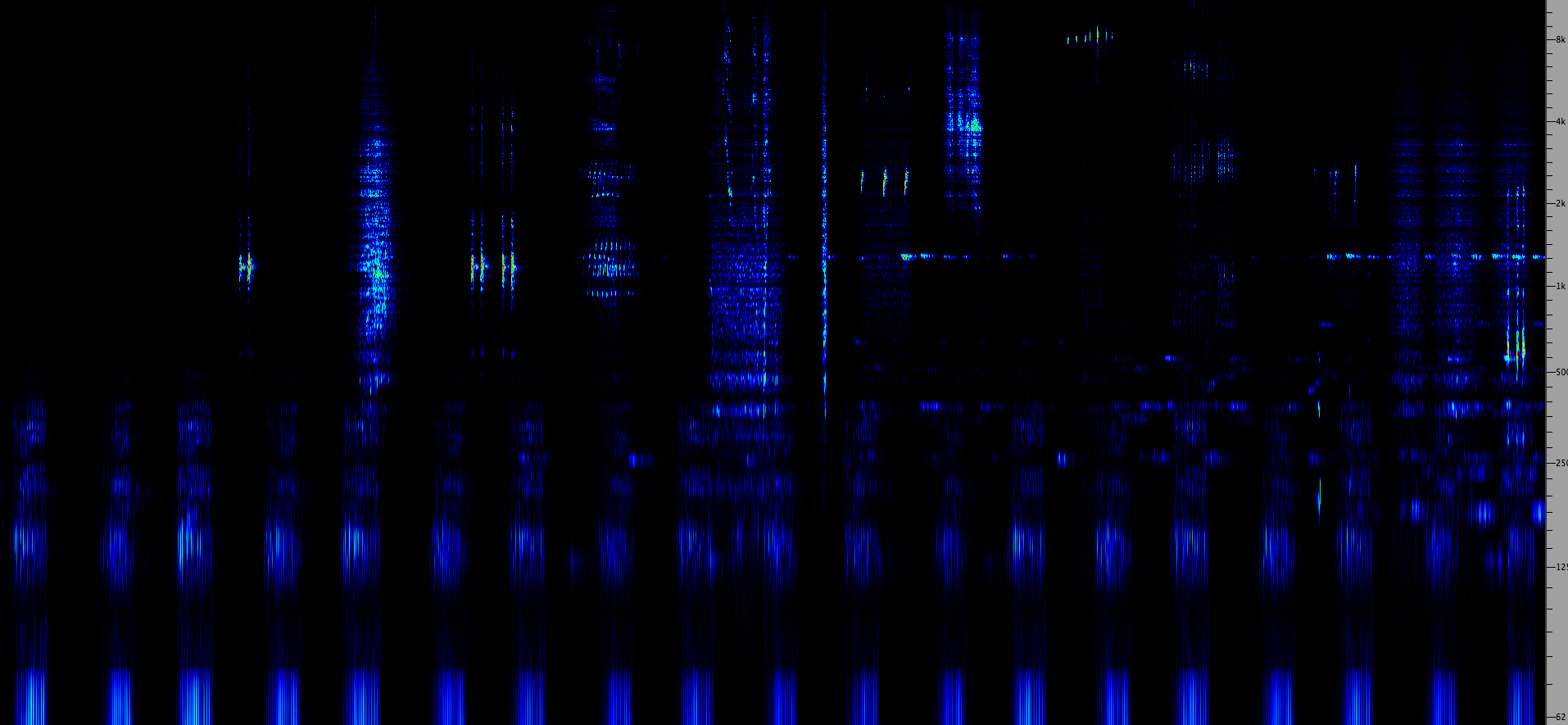
Click
to enlarge
|
Index
C. Moving spatial perspective. A moving
spatial perspective involves a smoothly connected space/time
flow, in other words, a journey. The reference model is of
course the soundwalk, although it can be interpreted
much more broadly than that.
For instance, the sense of movement may be embodied in the
recordings being used, or it can be simulated by various
processing techniques, some of which are derived from the
acoustics involved. For instance, reverberation is a key
indicator of the nature of an acoustic space, and the ratio of
the direct signal to the reverberant portion is a strong cue
for distance perception, as described in the Sound-Environment
Interaction module, and the studio demonstrations in the
Reverberation module.
As discussed above, a simple cross-fade between recordings
often suffices to suggest movement, even if it is unrealistic
in terms of the time frame involved or the absence of aural
cues such as footsteps or vehicular movement. Panning in the
stereo plane can also be effective, although the “phantom
image” that this creates is not very stable based on one’s
distance from a stereo pair of loudspeakers.
Binaural recording builds
in both external localization and a recognition of the
recordist’s own movement. However, it is not always clear
whether the listener will identify with the movement they
sense, or whether they feel they are just observing someone
else.
On the more general level of a moving perspective is the
concept and experience of a journey. Throughout history, myths
have often portrayed both mundane and heroic forms of the
journey, usually with a level of symbolism as to what it means
in human terms. Likewise, the literary form of the novel
usually involves an evolution of its characters,
psychologically as well as physically. Journeys, for instance,
are often metaphors for a coming-of-age story, for instance,
or the search for some truth or goal.
So, with this degree of richness in the semantic
possibilities, what can be done purely with sound? Given its
disembodied quality, sound has the advantage of suggesting
both a physical movement in an acoustic space, and a mental or
internal type of movement through memory and the imagination.
The latter is usually suggested by a transformation of
realistic sounds, and not just the old film cliché of the
image getting blurred and the sound becoming heavily
reverberated!
Here we will explore a variety of approaches in the
electroacoustic domain.
Classical cross-fade and reverb. The
first departure from the phonographic style of documentary
approach by the WSP, from edited field recordings towards a
more compositional approach, occurred with the preparation of
a track for the Vancouver Soundscape called “Entrance
to the Harbour”, published in 1973. The idea was to re-create
in sound a journey by boat from the outer limits of Burrard
Inlet, identified by the great diaphone (i.e. foghorn) at Pt.
Atkinson, a soundmark that dated back to the early 20th
century, past other foghorns at Prospect Point, Calamity Point
and Brockton Point, under Lions Gate bridge, into the inner
harbour. At the time, this trip could actually be made on a
ferry, since discontinued, and was familiar to many
Vancouverites.
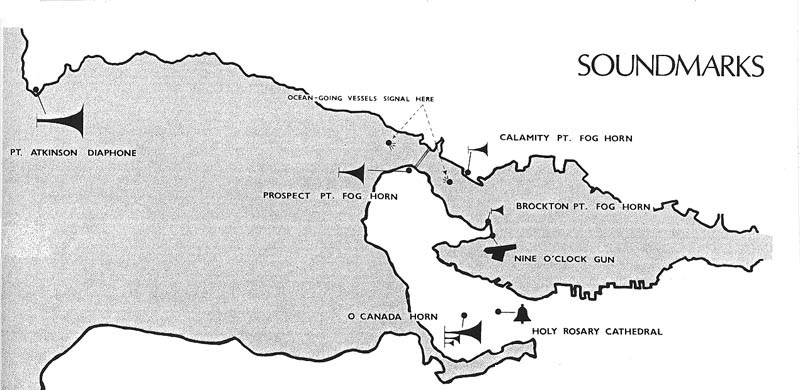
Vancouver soundmarks, 1973
However, there were at least two problems. The actual trip
took at least a half hour, and when the recordists rode on the
ferry, they only got boat noise. However, they also had
recorded the various foghorns separately as part of the
documentation of sound signals in the area, and could easily
record a typical docking procedure, including passengers
meeting friends and picking up their luggage in a very small
room with a squeaky door. Using these elements and some wave
ambience, they attempted to simulate the trip in a 7’ mix
using the simplest of cross-fade techniques and changing the
levels of the various horns so that they appeared to approach
and recede in the distance.
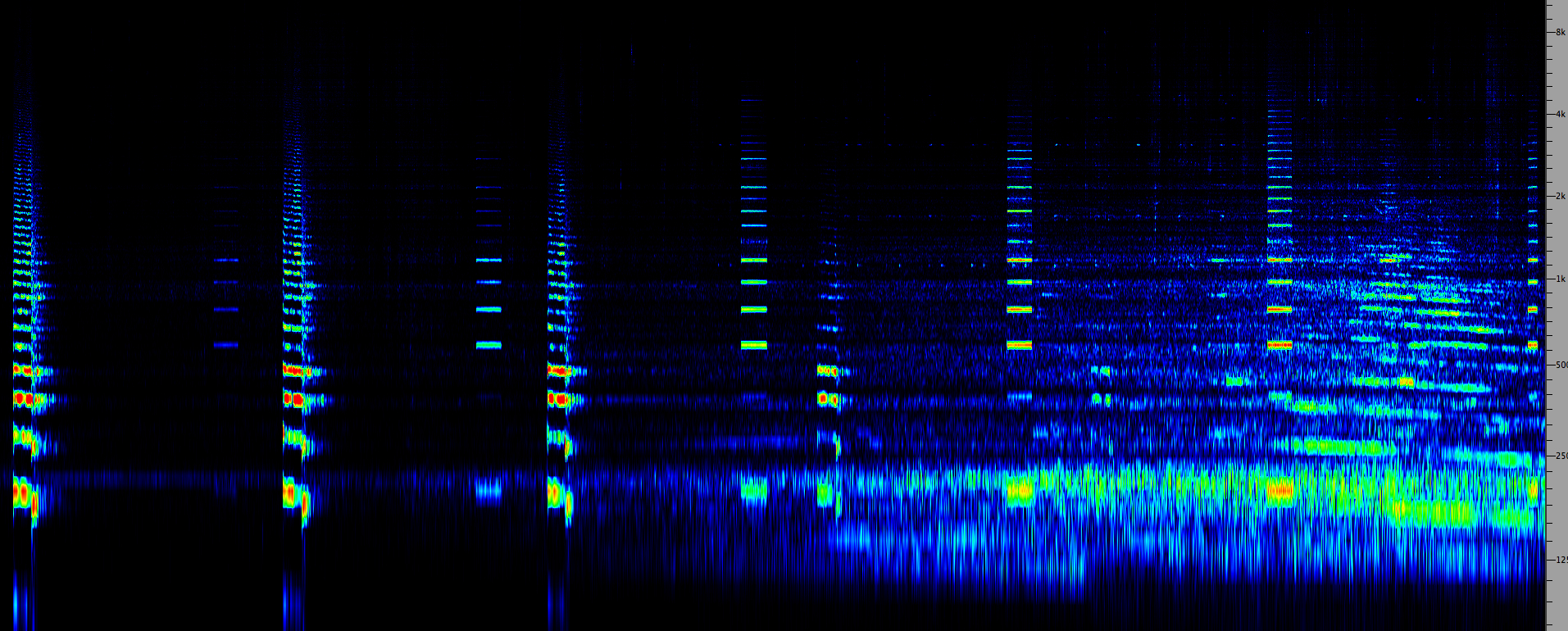
Spectrogram
of part one
Entrance
to the Harbour, Vancouver Soundscape 1973
CSR-2CD 9701
|
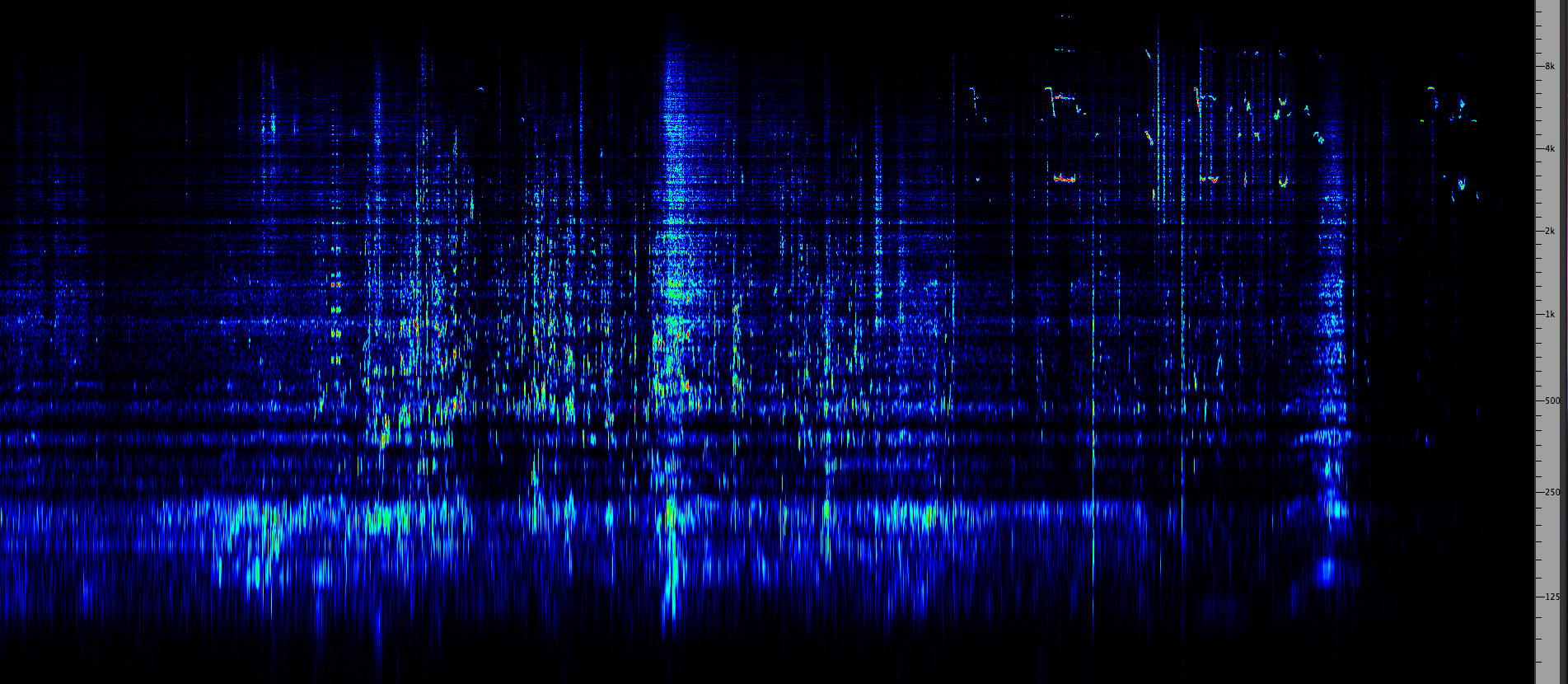
Spectrogram
of part two
(click either image to enlarge)
|
By today’s standards, the mix is quite crude
with illogical elements (the waves are clearly on the shore,
even as we imagine being on a boat, and the transition to the
docking sequence is fairly abrupt). Since the studio didn’t
have a proper mixer at the time, only rudimentary level
changes were possible. However, the foreshortening of the trip
to seven minutes and the illusion of approaching and passing
the foghorns, as well as the bridge and its traffic noise,
were strong enough cues to make it seem realistic.
The track can appear to be a phonographic style documentary
despite its flaws, but closer examination also shows a
compositional structure based on the journey format that has a
strong character. The beginning with the reverberation of the
foghorn off the mountains and across the water suggests a wide
open space and the natural geography of the area. Human sounds
don’t appear until the docking sequence, and indicate that we
are now entering the city itself. At the very end, the space
we are in (small and acoustically bright) is the very opposite
of where we started, suggesting a narrowing of the acoustic
space from very large and open, to enclosed and domestic.
Using a parallel circuit. The parallel
circuit, as described here,
involves splitting a signal into multiple versions, each of
which can be processed separately and mixed back together. A
simple example of this would be a cross-fade from the original
sound to a processed version. In my work The Blind Man
(1979) I cross-faded the original WSP recording of the
bells of Salzburg Cathedral – a very rich mix of seven bells –
with a filtered version of them that essentially removes the
attacks so we hear just the resonant partials. A description
of this analog process and the French studio where it was done
is presented here.
Text fragments from the poem by Norbert Ruebsaat were added to
the bell mix, as heard next. In particular, the line “already
it has come and is leaving again” – intended to describe the
wind – is reflected by the bells which have rung, but then
without their attacks seem to have left, leaving only their
memory and resonances. Mirroring a text with an appropriate
sound transformation can be quite satisfying, and help
listeners understand the text on multiple levels.
Bell and text sequence from The Blind Man (1979)
on Digital Soundscapes, CSR-CD 8701 |

Click
to enlarge
|
Layering
the part and the whole. In La Sera di Benevento
(1999), the soundscape begins in the local train station
in Benevento, Italy, with a train arriving. A smooth
transition in the train sounds which are increasingly
resonated takes us into a kind of daydream with a fountain and
afternoon cicadas. Can you spot the first transformed sounds – hint, there
are two.
Opening
of La Sera di Benevento (1999)
on Islands, CSR-CD 0101 |
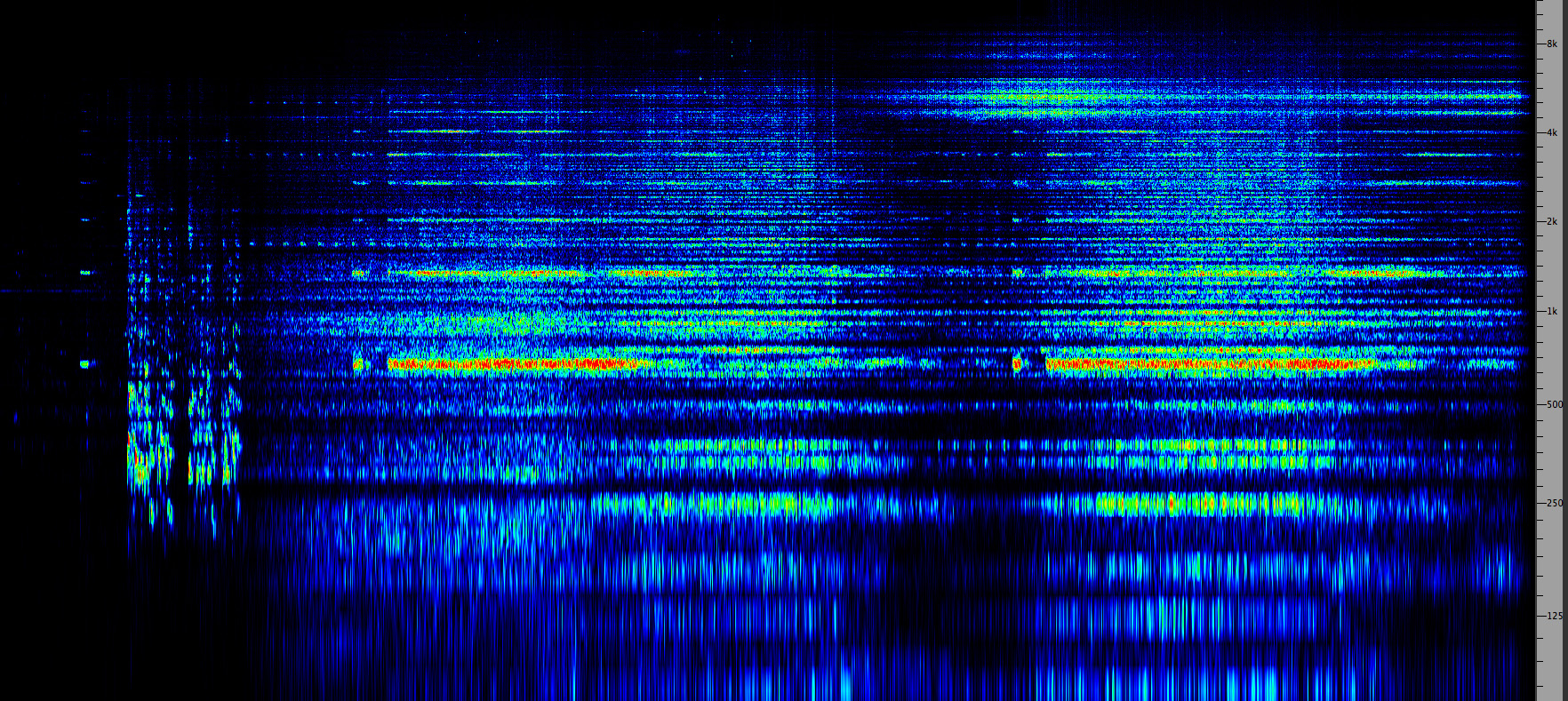
Click to enlarge
|
The first transformed sound in the above
example is actually the squeaky wheel from the train at 0:29
which is looped and mixed with the train – a kind of
repetition that is entirely plausible with trains, even though
this squeak actually happened only once. The second sound is
the whistle at 0:39 (the same one heard first at 0:12), but
this time it is granulated, then stretched, which is where
most listeners will identify a transformation. Listen to the
opening again to hear how that worked.
The squeaky wheel is resonated, similar to the example above
from Island, on pitches that are consonant with the
horn, so that by 1’ the resonant drone takes over. There is a
brief lull at 1:30 as the cicadas are introduced, and then
we’re back to the train horn and drone. An Italian poem is
introduced later. The intent is to lead the listener seamless
into a daydream on a hot afternoon in southern Italy.
In fact, the repetitive rhythms of trains passing (called ostinati
in music) are very tempting to process, since a simple loop
taken from them is easy to edit out and repeat in synch with
the original recording. A slightly more complex version of
this parallel processing (by multi-tracking) was used in Pendlerdrøm,
introduced above, with much larger trains in the Copenhagen
station.
In fact there were two such loops used simultaneously, as
shown below as the Source for tracks 3&4 and 5&6. Each
loop is resonated at two different pitches (for the left and
right channels), and gradually the feedback is raised until it
becomes a resonant drone. Note that the percussive rhythm in
the second loop keeps its rhythm going.
Tracks 1&2 use a filtered version of the high frequency
brake sound that is time-stretched and resonated as well. The
mix of all three stereo tracks creates a smooth daydream
effect, but also notice that tracks 7&8 have a
untransformed engine sound that keeps us grounded in the
realistic soundscape already created.
First
passing train loop
Second
percussive train loop
|
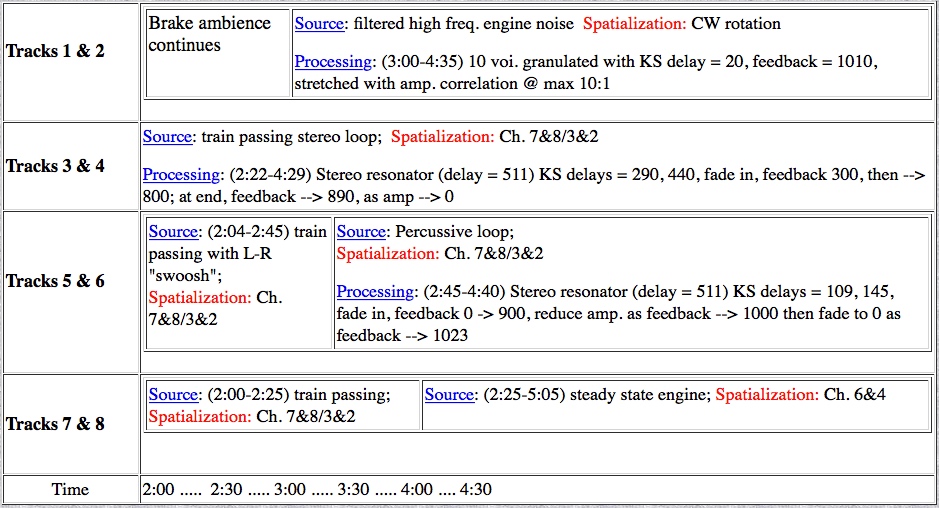
Production
score of first daydream in Pendlerdrøm (1996):
click to enlarge
|
First
daydream sequence in Pendlerdrøm (1996)
from Islands, CSR-CD 0101
|
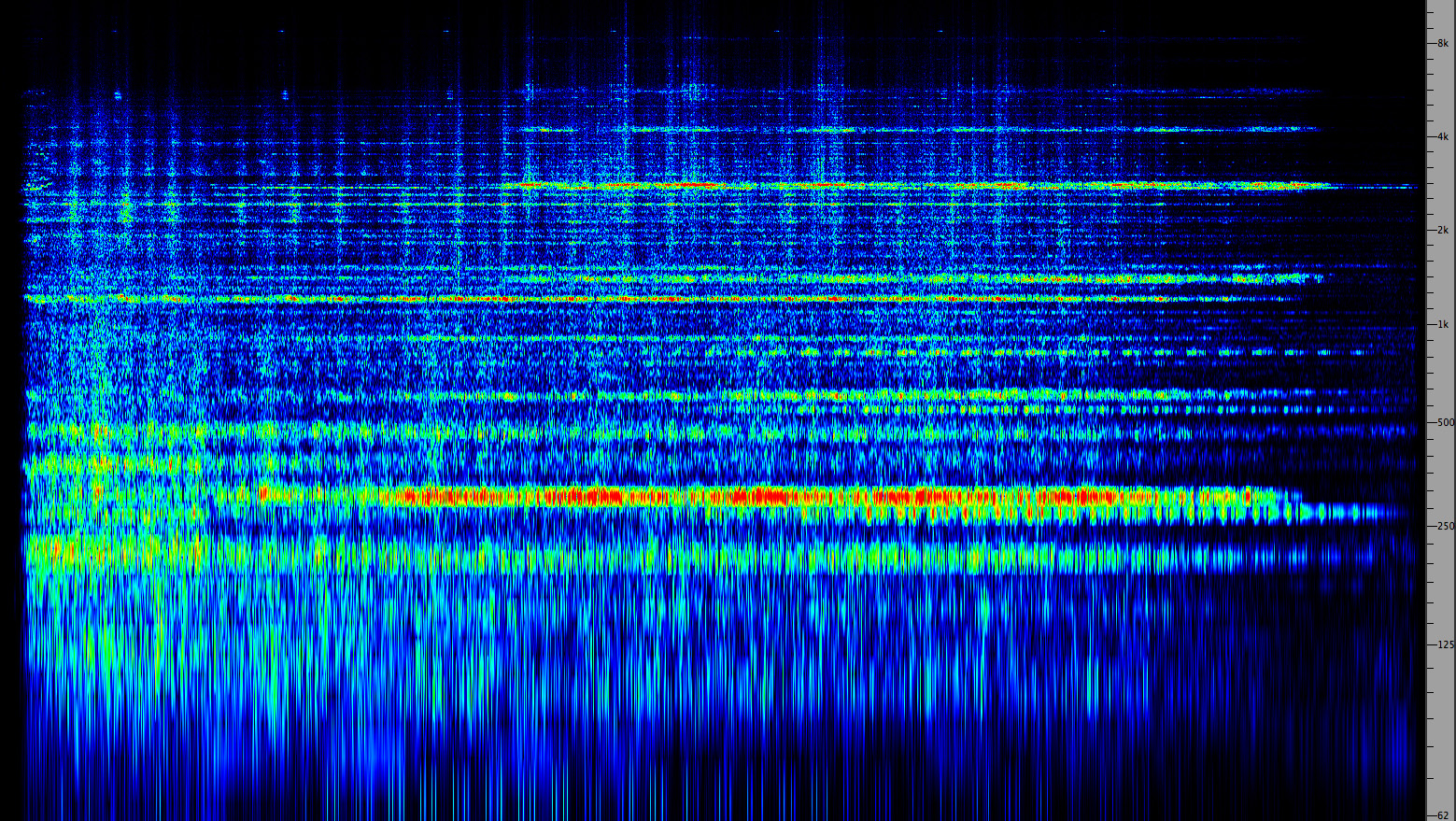
Click
to enlarge
|
The
second daydream section in the piece, once we’ve settled down
on the smaller commuter train, is handled similarly, with two
stereo tracks being resonated, including a percussive wheel
drone, and the sound of brakes an octave lower, resonated and
stretched. The transition into the daydream is faster (I guess
our commuter is really tired at the end of the day) and a
random collage of short bits of sound from earlier in the
piece (mainly voices and signals) come back in short loops
that are repeated and resonated, a little like flashbacks or
“earworms” that go through one’s mind during relaxation.
So, the final challenge is how to get out of this daydream. In
this example, we hear the end of the drone sequence where even
the resonated soundbytes are fading into the overall texture,
and then as the train slows down we hear a station being
announced, and there is a huge percussive chord as our
commuter suddenly wakes up with a start.
In fact, this sound is derived from a simple door slam on the
train itself that was heard earlier from another train where
passengers were getting off, but it has been significantly
enhanced with a resonator and a 5:1 granulated stretch factor.
We then hear the door signal as it opens, our commuter gets
off and walks down a wooden staircase into the outdoors and
the piece ends with what sounds like a cigarette or pipe being
lit.
Train
door slam (original source)
|
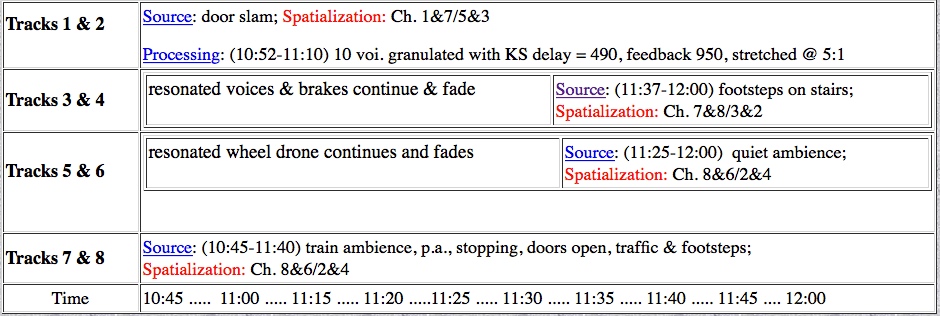
Production score for the ending of Pendlerdrøm
(1996): click to enlarge
|
Ending
of Pendlerdrøm (1996)
from Islands, CSR-CD 0101
|
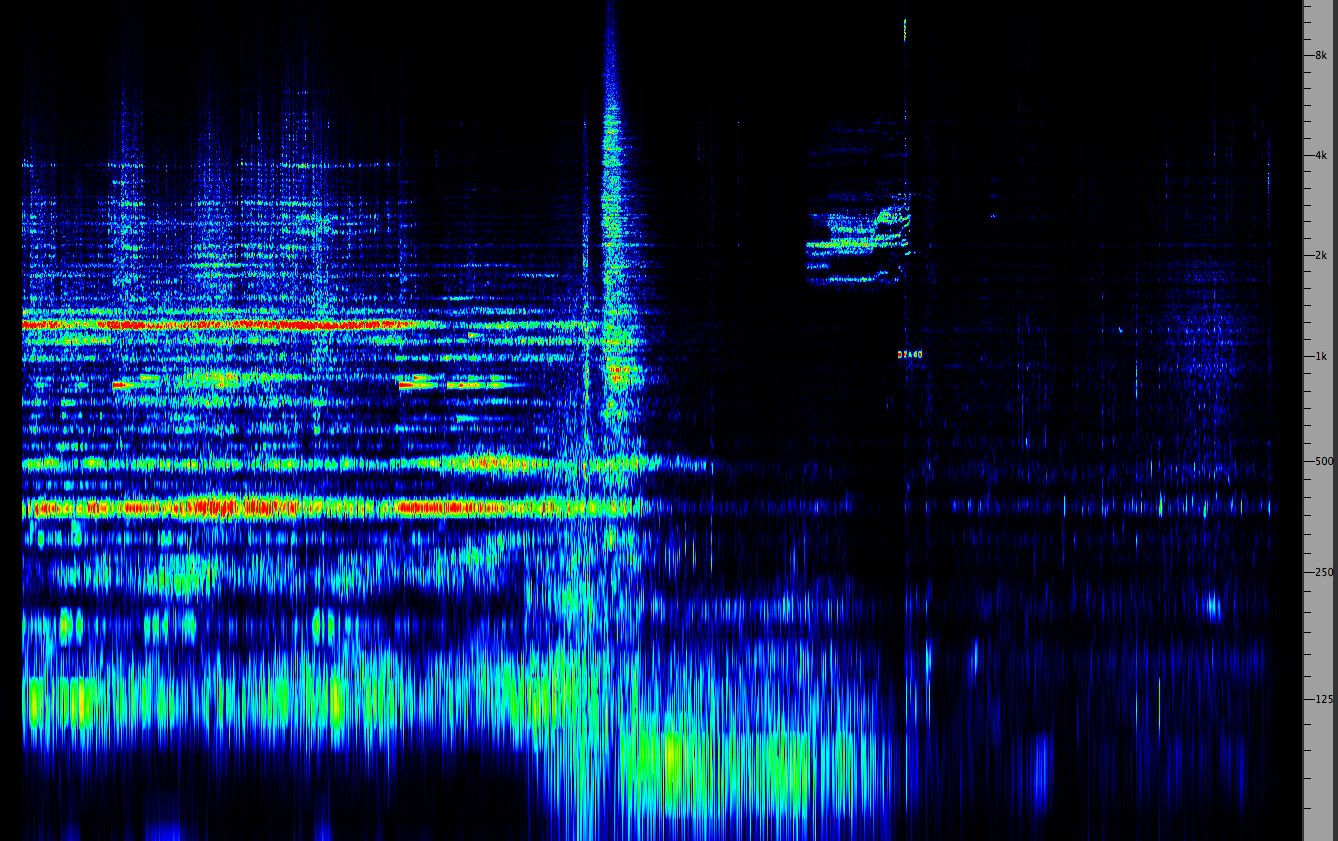
Click
to
enlarge
|
Because the original sound material was recorded around 6pm,
the scenario of the commuter going from Central Station to
home seemed a natural choice. However, for reasons only known
to the Danish recordist, he actually recorded it in the other
direction, going from the suburbs to downtown, so the
sequences from his recordings had to be re-ordered to go in
the other direction, and so far no one has noticed or
objected.
The final example in this section is from
Anne Holmes’ Wood on Wood on Water (1978), a
quadraphonic piece with a coastal soundscape. The journey in
this case is not a physical one, but is a bit opposite to the
daydream in Pendlerdrøm, namely a transition into a
high attention state where all of the background noises fade
away.
The featured sound is a series of simple hits on a beached
log, which is quite resonant on its own, but then a virtuosic
percussion performance emerges (created with tape delays,
although it could be mistaken for an actual percussion
ensemble). The dynamic sounds move into the foreground and are
so engrossing, we’re not likely to hear that the tide is
gradually coming in (a common experience at a tidal beach).
A
beached log improv from Anne Holmes’ Wood on
Wood on Water (1978)
from SFU-40, CSR-CD 0501
|
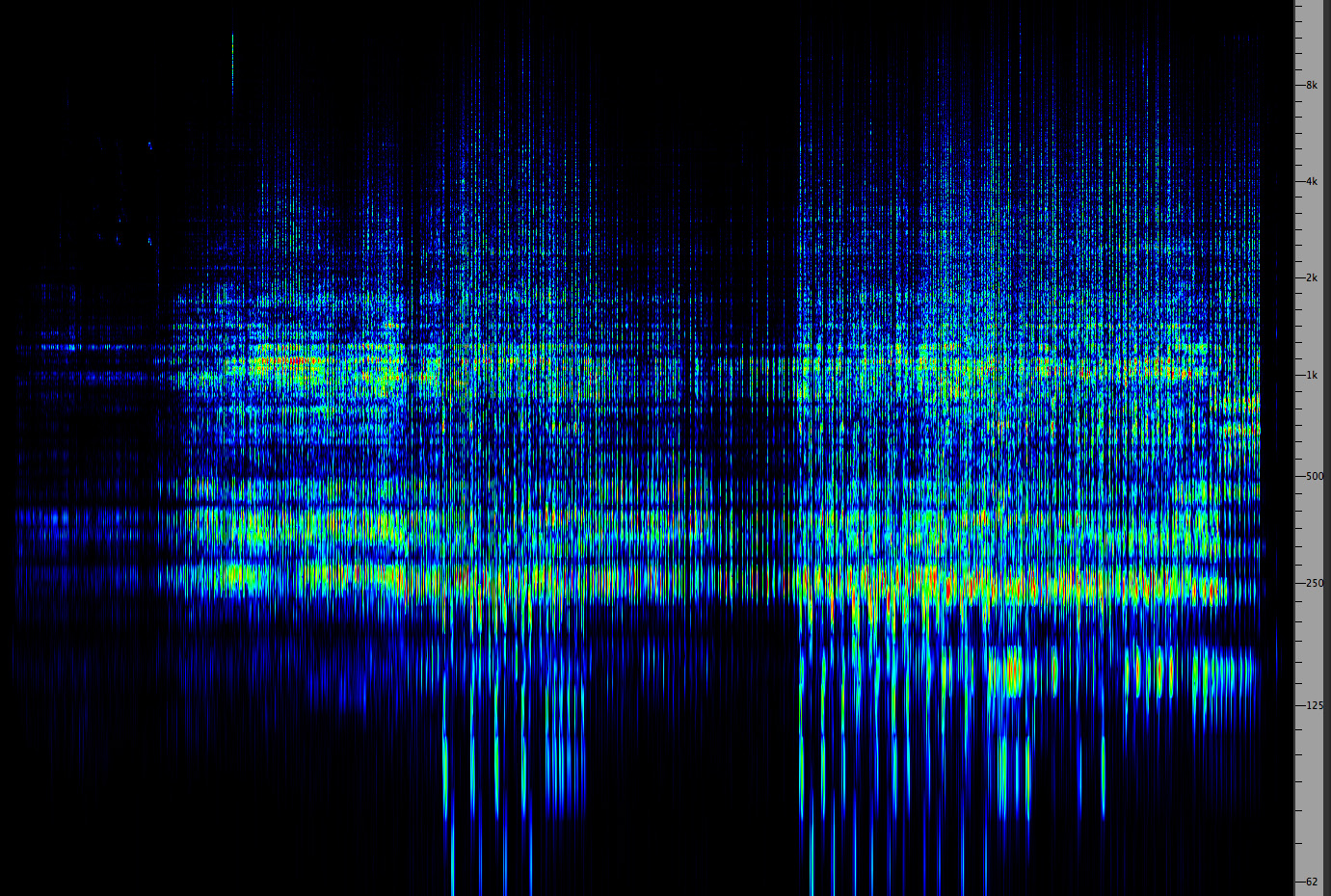
Click
to enlarge
|
In the
section following this excerpt, even the seagull cries
disappear, until finally at the end of the concert, there is a
sudden surge of the tidal waves as we realize what has
happened to the tide in the meantime. Gradually towards the
end, water engulfs the log and it loses more and more of its
high frequencies and resonance, until it is finally submerged,
showing that wood and water are opposites in many senses.
Eventually the seagulls return (also to our awareness) and the
piece ends.
Other examples of a moving perspective will be presented in
the final section.
Index
D. Abstracted spatial perspective.
Here we will group together a variety of approaches to
soundscape composition that do not fall simply into a fixed
or moving perspective model. To use similar terms, we could
say that they exhibit discontinuous space/time
flows. However, to put it more positively, we could also say
that they present their material from multiple perspectives,
or in an abstracted, even symbolic manner.
However, keep in mind that in the electroacoustic era where
we daily hear a mix of acoustic and electroacoustic sounds,
it has become customary to hear technological sounds embedded
in the everyday soundscape. Murray Schafer referred to this
phenomenon as schizophonic
to emphasize the split between the source and its reproduced
form, and occasionally the “fit” still has a disruptive or
“nervous” quality about it. However, we usually adapt
quickly and normalize the presence of such embedded sounds,
even as we understand that they are in the
environment, but not of it.
The first example is a simple montage
(i.e. edited) string of Vancouver sound signals, that was
called (for better or worse) “The Music of Horns and
Whistles” when it appeared on the Vancouver Soundscape
1973 vinyl recording. The fact that all of the sounds
are pitched made it easy in those days to refer to them as
musical, and the track itself was often the one selected by
others to showcase the WSP work.
Excerpt from The Music of Horns and
Whistles
from The Vancouver Soundscape (1973),
CSR-2CD 9701
|
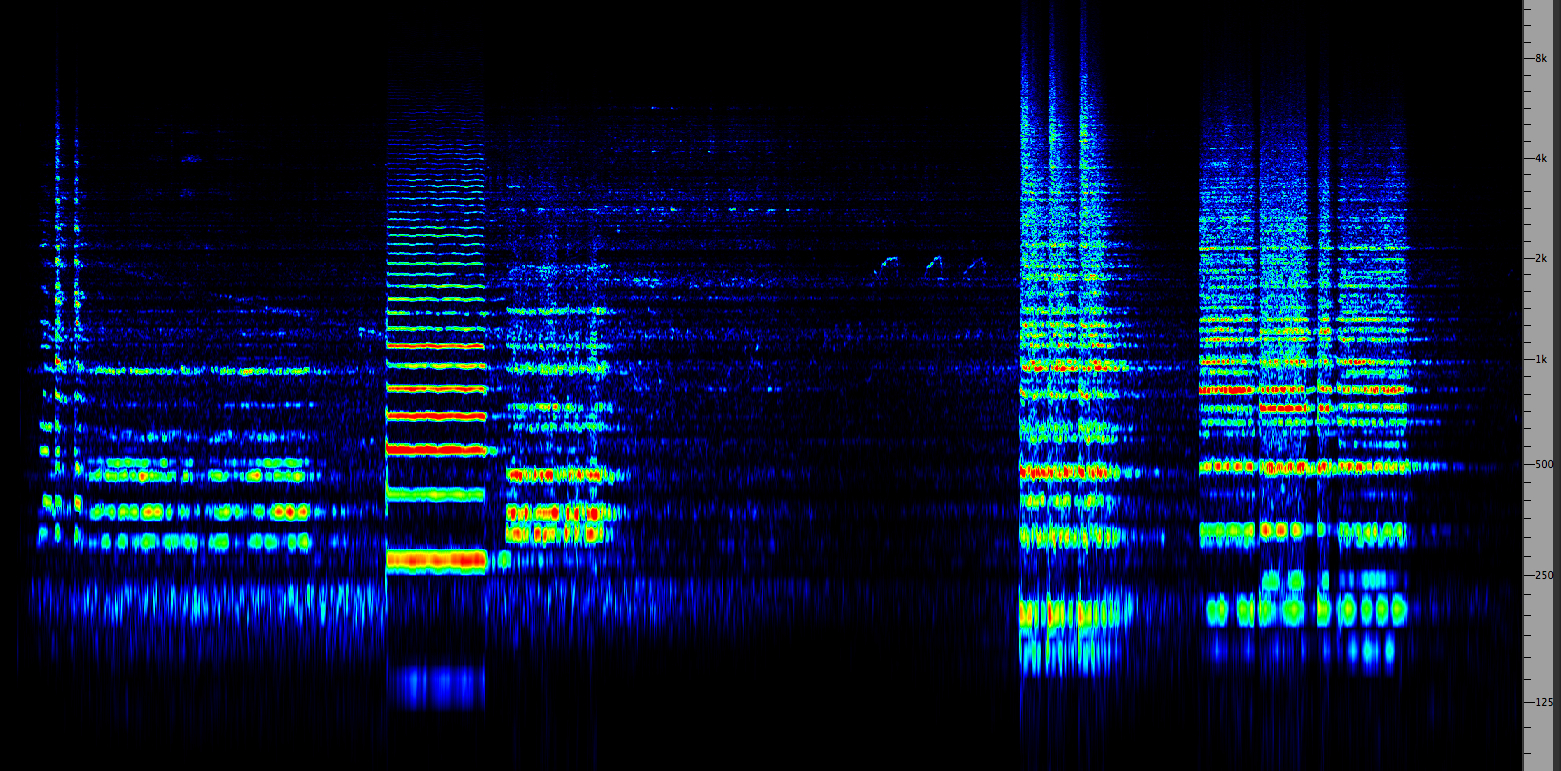
Click to enlarge
|
In the current context, there is simply a common theme to
the track – all of the sounds you hear, along with an
appropriate ambience, are typical Vancouver signals as a
port city, the end of the transcontinental railway line,
with an industrial harbour and mountains on one shore which
adds a natural reverberation to many of these sounds. This
excerpt is the last minute of the 3-minute track.
Next we have my Pacific Fanfare (1996),
an anniversary tribute to the WSP that begins with a 30”
montage of Vancouver soundmarks, the Pt. Atkinson diaphone
heard earlier in this module, the 9 O’clock Gun in Stanley
park, the Royal Hudson steam train whistle, the B.C. Ferry
horns at Horseshoe Bay, and the Holy Rosary Cathedral bells.
Immediately following this opening, we hear many of these
sounds time-stretched (as documented in the Microsound module) and
resonated. Compared with the simple identification of each
sound at the beginning, we now have a more reflective
listening experience of hearing “inside” them as their
evolution plays out. There are also new soundmarks
introduced such as the light rapid transit Skytrain (with a
bit of sly humour when the characteristic starting motor
sound is slowed down). The piece ends with the O Canada
horn, sounding at noon downtown, and in the distance, the
transcontinental Canadian Pacific Railway (CPR) train
whistle in the distance, a reference to its historic role in
uniting the country east to west.
Pacific Fanfare (1996)
from The Vancouver Soundscape (1973),
CSR-2CD 9701 and Islands CSR-CD 0101
|
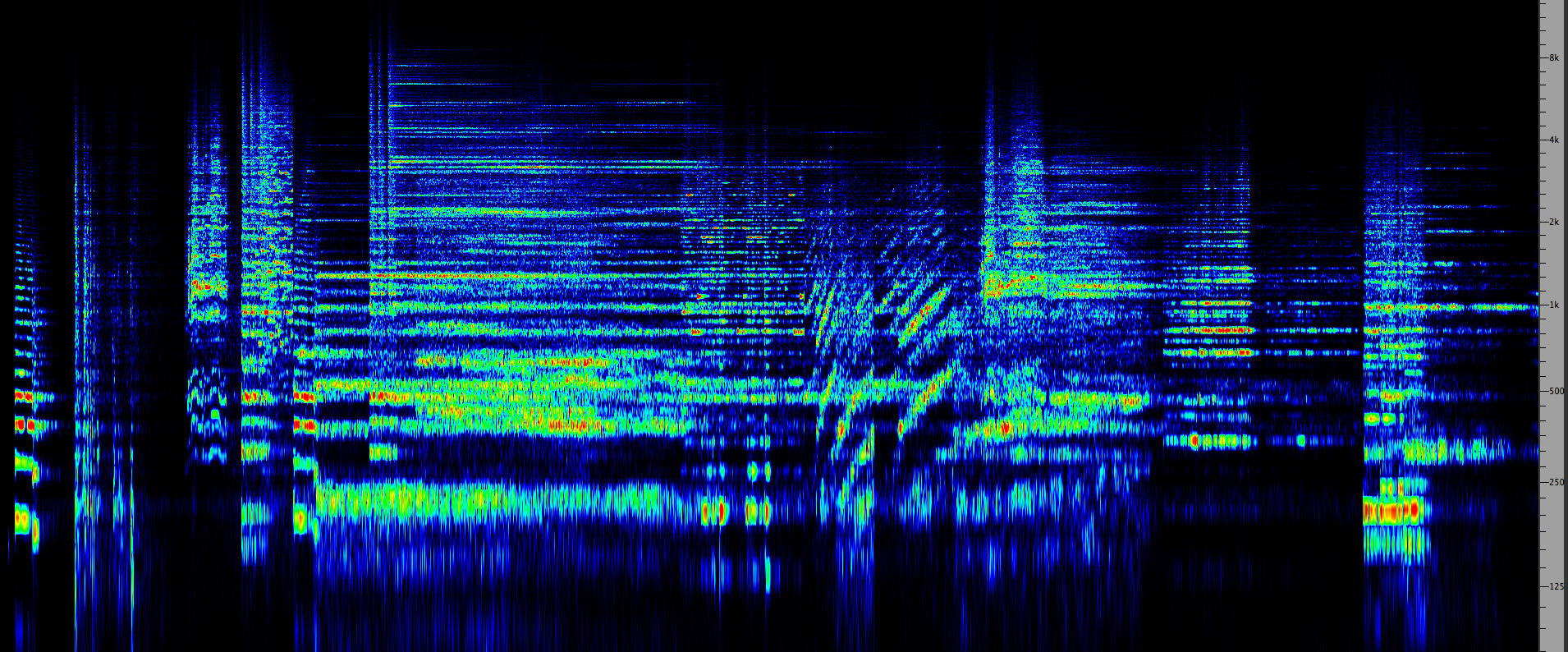
Click to enlarge
|
Next we present two movements of Canadian
composer Claude Schryer’s Vancouver Soundscape Revisited
(1996) who refers to the piece as “an impressionistic
portrait of the musicality and poetry of the soundscape of
Vancouver”. In terms of this presentation, it is also a good
example of an abstracted perspective on the soundscape of
the city, based on the WSP’s recordings which were collected
in the 1970s and 1990s.
The second movement of the piece, Fire, seems like a
stream of consciousness in its often surprising
juxtapositions of the city’s sounds. However, it is not at
all random. Schryer catalogued the sounds he chose from the
WSP collection in terms of spectrum, category, function,
pitch and context, and in this movement he linked the sounds
together according to one or more of these aspects they had
in common.
He made only small modifications in terms of level or pitch
to facilitate smooth transitions, one exception being the
downward transposition of the foghorn at the very end. Fire
being notoriously volatile, that metaphor allows quite free
associations with the energy of these sounds, dynamic at the
beginning, slowly subsiding to some final embers at the end.
The fourth movement is called Noise and begins and
ends with a complaint about that kind of disruption,
followed by a more literal series of examples.
Claude
Schryer's "Fire" movement, Vancouver Soundscape
Revisited (1996)
from Soundscape Vancouver 1996, CSR 2CD-9701
|
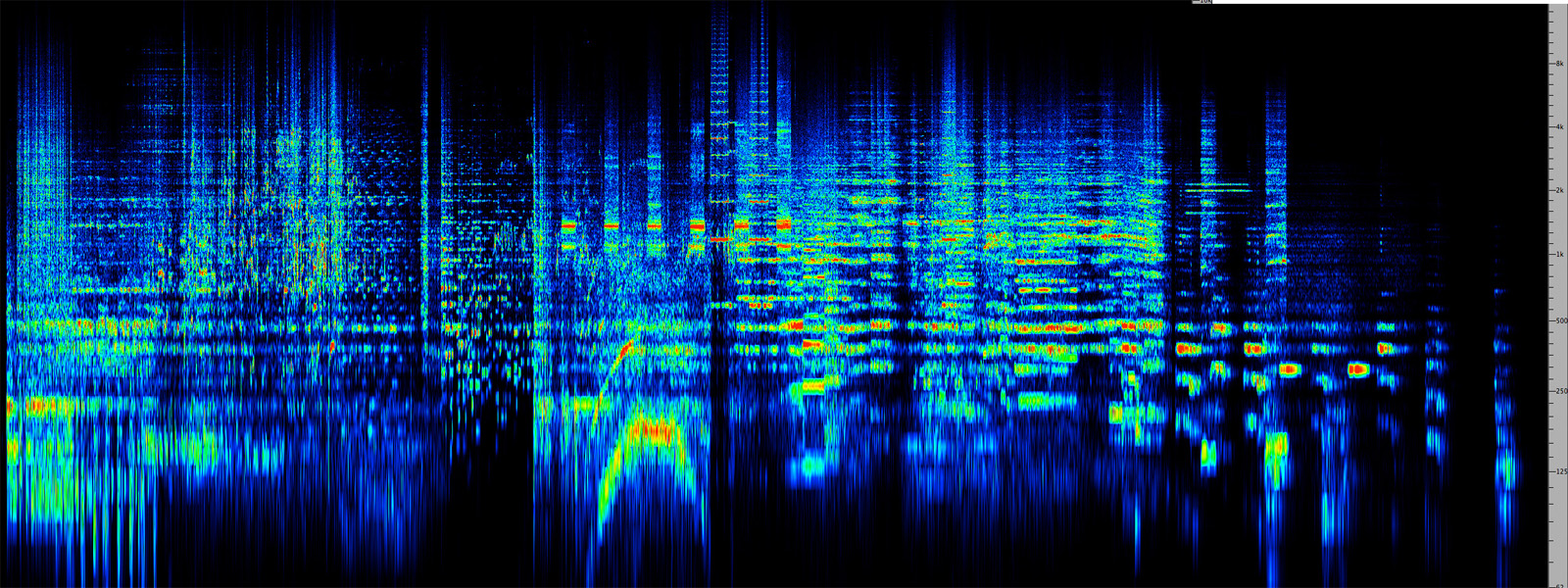
Click
to enlarge
|
Claude
Schryer's "Noise" movement, Vancouver Soundscape
Revisited (1996)
from Soundscape Vancouver 1996, CSR 2CD-9701
|
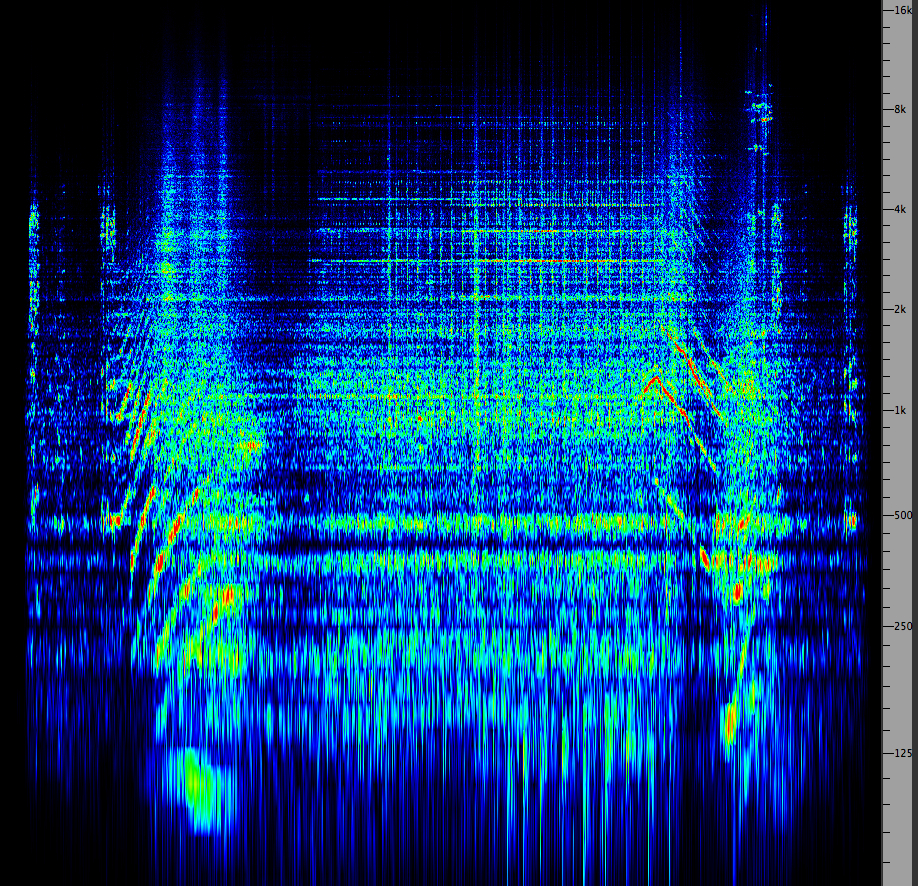
|
A final example in this section is from the
German composer Hans Ulrich Werner who has specialized in
radiophonic work, including Vanscape Motion (1996),
which like the Schryer work, was composed for the Soundscape
Vancouver project and double CD in 1996.
In this excerpt from the piece, the spatial perspective is
abstracted by reversing their more usual presentation.
We hear the sequence of foreground signals used in The
Music of Horns and Whistles from the 1973 Vancouver
Soundscape publication, but they are in the background, and
act as a kind of memory, perhaps emphasizing their historical
nature. In the foreground is a sequence of reverberated waves
and water splashes that place them in a different space
altogether, one of intimacy and repose. This technique of
having two different acoustic spaces with highly contrasting
affect seems to facilitate reflective listening.
Excerpt
of Hans Ulrich Werner's Vanscape Motion (1996)
from Soundscape Vancouver 1996, CSR
2CD-9701
|
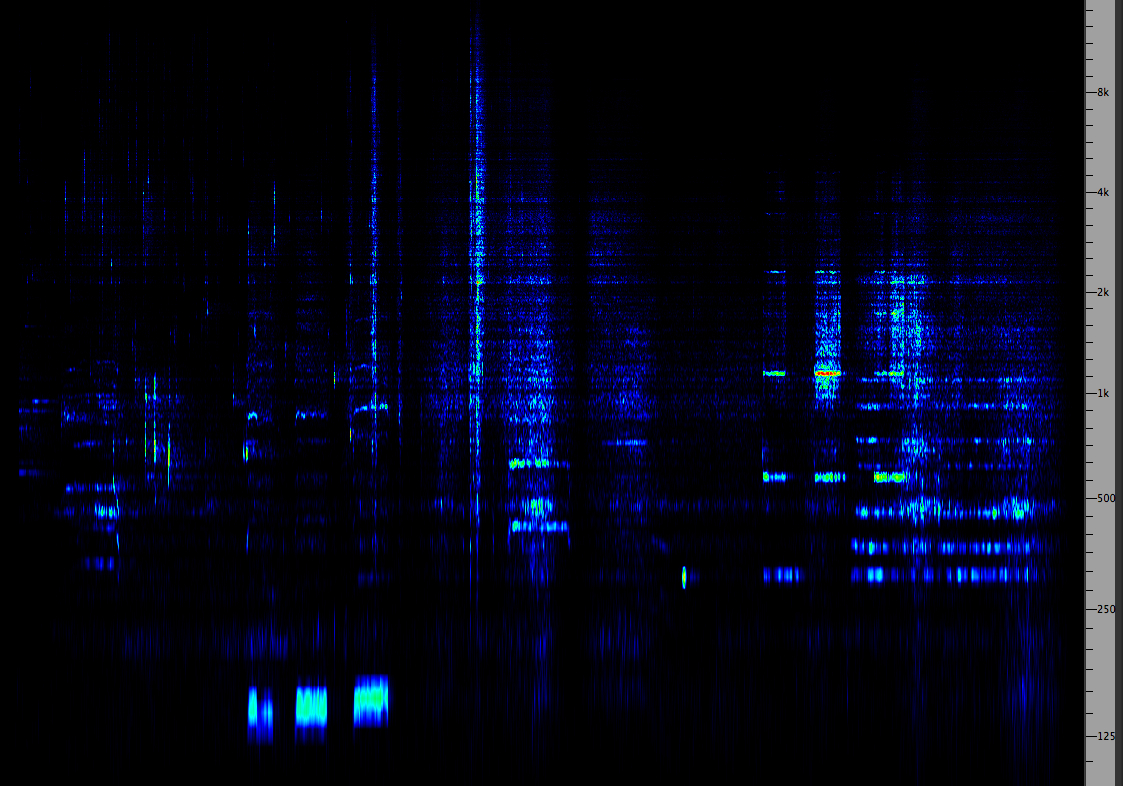
Click to enlarge
|
Index
E. Detailed analysis of specific
soundscape compositions. Here we will present a more
detailed analysis of some specific pieces by Hildegard
Westerkamp and Barry Truax. Although published on CDs in
stereo, these pieces are usually performed in 8-channel
format which provides an immersive effect for the listener
which in some cases simulates an actual acoustic space or an
abstracted version of it that creates a virtual soundscape.
Hildegard’s work Into the Labyrinth (2000) is one of
several pieces composed in the context of visits she made to
India which included workshops and soundwalks with people
there. She describes the work as a “sonic journey into
aspects of India’s culture. It occurs on the edge between
dream and reality, in the same way in which many visitors,
myself included, experience this country.” The piece has
been published on the Earsay CD, Into India.
It clearly falls into our above category as an abstracted
soundscape where highly realistic environmental sounds
are combined with their transformations. She has generously
documented several of these transformations which are
presented in this sidebar.
They follow the tradition of sound object transformation,
including pitch transpositions, equalization and mixing
variants into more complex sound clusters, similar to the
studio demonstrations used throughout the Tutorial.
In these examples, notice how exploratory they are,
and how at certain key points, a feature will emerge that
obviously caught her ear, and subsequently was utilized in
the next stage of the process, such as the resonance heard
on one of the strikes in the stone chipping recording from
Rajasthan, once it was transposed down 8 semitones and then
an octave which stretched it further.
The examples also reveal some practical details about how to
separate a sound, such as the bicycle bell from Delhi,
recorded on a busy street, from its noisy ambience into a
more useful form. It eventually becomes both a resonant
drone when stretched and pitch shifted by 6 octaves, as well
as a cloud of bells when different pitch shifts are combined
and transposed.
The extremely high pitched “singing crickets” from Goa, as a
whole and in two isolated recordings, also create rich
textures when transposed to which Hildegard has added reverb
that gives them a unique acoustic space, as in the sidebar.
Here we present a stereo mix of the opening of the piece
which evocatively introduces the Indian soundscape in a
series of overlapping vignettes that seamlessly mix the
realistic sounds with the processed ones, or as she puts it,
places them “on the edge between dream and reality.”
Opening of Hildegard Westerkamp’s
work Into the Labyrinth (2000)
from Into India, Earsay CD
|
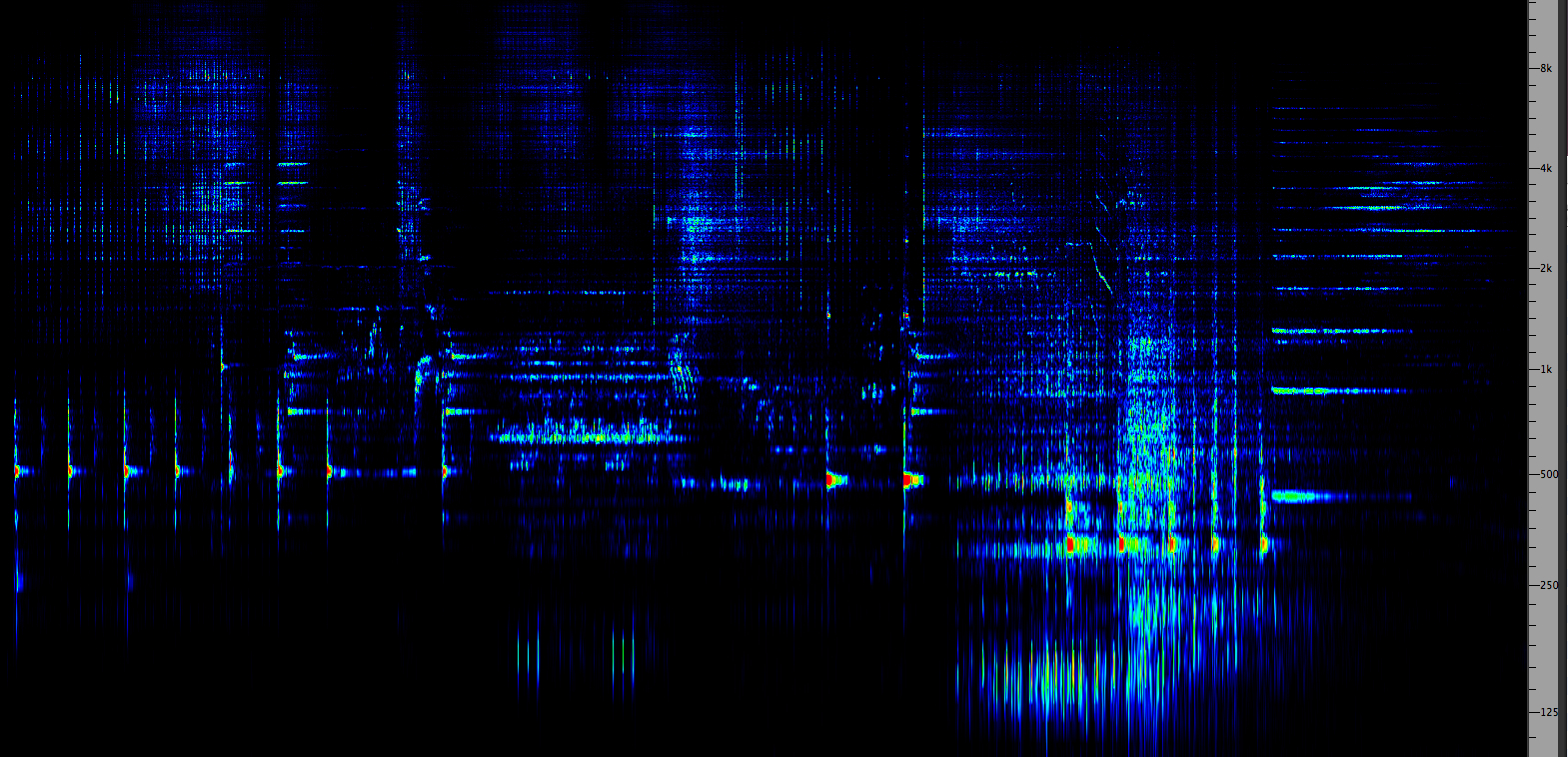
Click to enlarge
|
Hybrid Convolution. In other
modules, we have covered the basic theory and practice of
convolution via Impulse
Reverberation and Auto-convolution.
The special case of auto-convolution where the sound is
convolved with itself leads to the question as to what will
happen when we convolve two different sounds together.
Since convolution involves a multiplication of the
frequencies which the two sounds have in common, our first
expectation is that it will be worthwhile to pursue this
hybridization only when there is significant overlap
between the spectra of the two sounds. High
frequencies convolved with low simply won’t produce very
much, if at all.
It was with a curiosity to find out the answer to this
question that I embarked on experiments in 2009 with what
I’m calling hybrid convolution. Even the first
results were so inspiring that within an amazingly short
period of time I was able to create an 8-channel work called
Chalice Well (2009) and premiere it at the Sonic Arts
Research Centre’s Sonic Lab in Belfast on a 32-channel
speaker rig which gave it the added height that was needed.
Previous casual experience showed that if you combine two
broadband sounds together, you only get an undifferentiated
wash of sound that isn’t useful for much other than an
ambient track. So, why did these initial experiments
succeed? First, the materials used were environmental
recordings, mainly of watery sounds, but also glass
breaking, bubbles in water, sharp percussive sounds of locks
and doors, and some gated and transposed male phonemes.
These were convolved with themselves, and two other types of
sounds, a female vocal text, and four examples of sine-wave
granular synthesis.
The key element to the success of the experiments was that
all of these sounds were “pointillistic” in a sense, that
is, with micro attacks in their textures, including
a few major percussive events, such as a water splash. This
characteristic gave the convolved sounds a similar, extended
texture that seemed to be a hybrid version of the two
component sounds.
The second element that was suggestive of a possible
soundscape was that some of the watery sounds (recorded by
David Monacchi in Italy) were deep in a well that had its
own resonant properties. When extended, these sounds had a
reverberant quality. So, if we categorize the source sounds
as dry or wet (no pun intended), we get the following
spatial result when they are convolved with each other:
Dry with dry produces a foreground sound
Dry with wet produces a middle ground sound
Wet with wet produces a more distant sound
There is a full documentation of all of the sounds used in
the WSP Database, but since there were more than 200 hybrids
produced, we can’t include them all here. Instead, we will
put a selection of them in a sidebar.
A third variable that came out of the
experiment and was particularly valuable for creating an
8-channel space was the discovery that file A convolved with
B was not the same as file B convolved with A, as
some texts might imply. After a quick consult with Tom Erbe,
the creator of SoundHack, the reason became known.
Convolution will be symmetrical (A*B is the same as
B*A) but only when the analysis window is
rectangular, that is, no slope to the window. The analysis
windows I was using were typically the Hamming variety which
has slopes on either end. So, even though the results of A*B
and B*A were similar in terms of their spectra and texture,
their global amplitude envelopes were quite different as
shown below.
This proved to be useful because more variants could be
generated to fill up the 8-channel space. The differences in
amplitude envelopes provided an extra spatial dimension for
the sound to seem to move around the space. It is quite
interesting to consider that this difference at the micro
analysis level could make such a larger difference at the
macro time scale – yet another instance of the nature of the
microsound domain.

Water*Well
|

Well*Water
(click to enlarge)
|
As to the macro compositional level
of the piece, the image of a well came to mind early on
because of the Italian source material, and my experience in
visiting Chalice Well at Glastonbury in the south-west of
England, a holy site steeped in legends and myths. Wells
sometimes have a certain aura about them, as this one did,
despite the fact that, being covered, there was little in
the way of sound to be heard.
However, in reading about the many myths associated with the
Well, the one that made an impression was the legend that
underground caverns exist below it, and that this is where
Joseph of Arimathea buried the chalice known as the Holy
Grail, in order to protect us from evil. These caverns have
never been discovered, and historians are quick to point out
that many legends were in fact created by the monks in the
Middle Ages to boost tourism (some things never change!).
But, in the case of soundscape composition, we are not
dependent on referring to actual space, and the sounds I was
generating with hybrid convolution suggested an imaginary
virtual soundscape, and a soundwalk type of moving
perspective through it.
Here are two excerpts in stereo reduction from the piece,
the first starting at the 4’ mark for a scene I call The
Chamber of the Feminine. The name refers to the historical
gendering of the well as feminine, and some of the source
material included a female voice reading from the Song
of Songs about a well (not that you’re going to
understand any words but the files referred to below are
identified as "AWell" and "AFount"). When convolved with
other sounds, the female formants come through and seem
blurred and sustained enough to be symbolic.
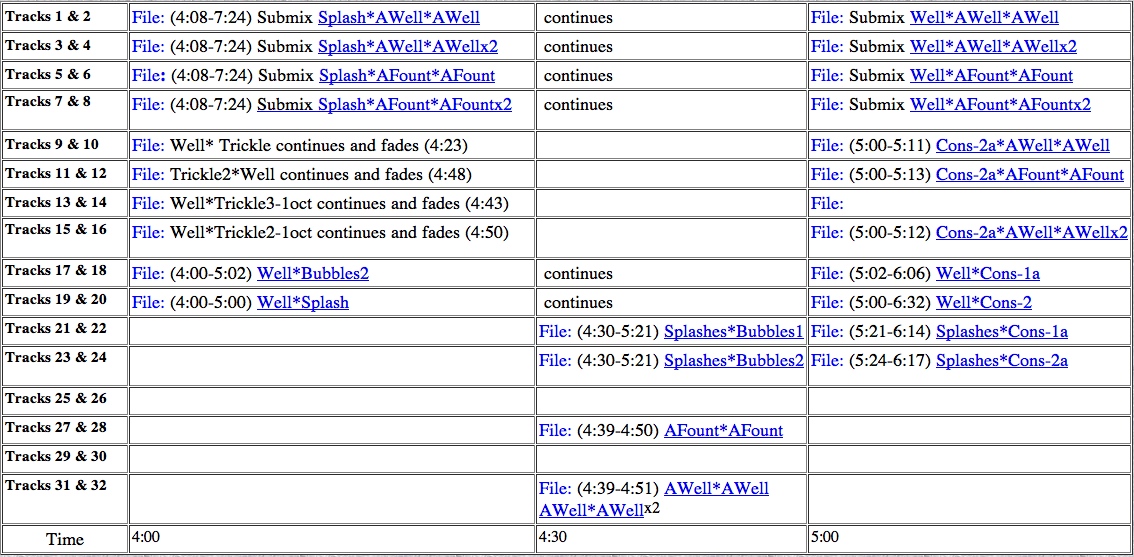
Production score of Chalice Well, Chamber of the
Feminine
Excerpt
of Chalice Well (2009)
Chamber of the Feminine
starting at 4'
from The Elements and Beyond, CSR-CD 1401
|
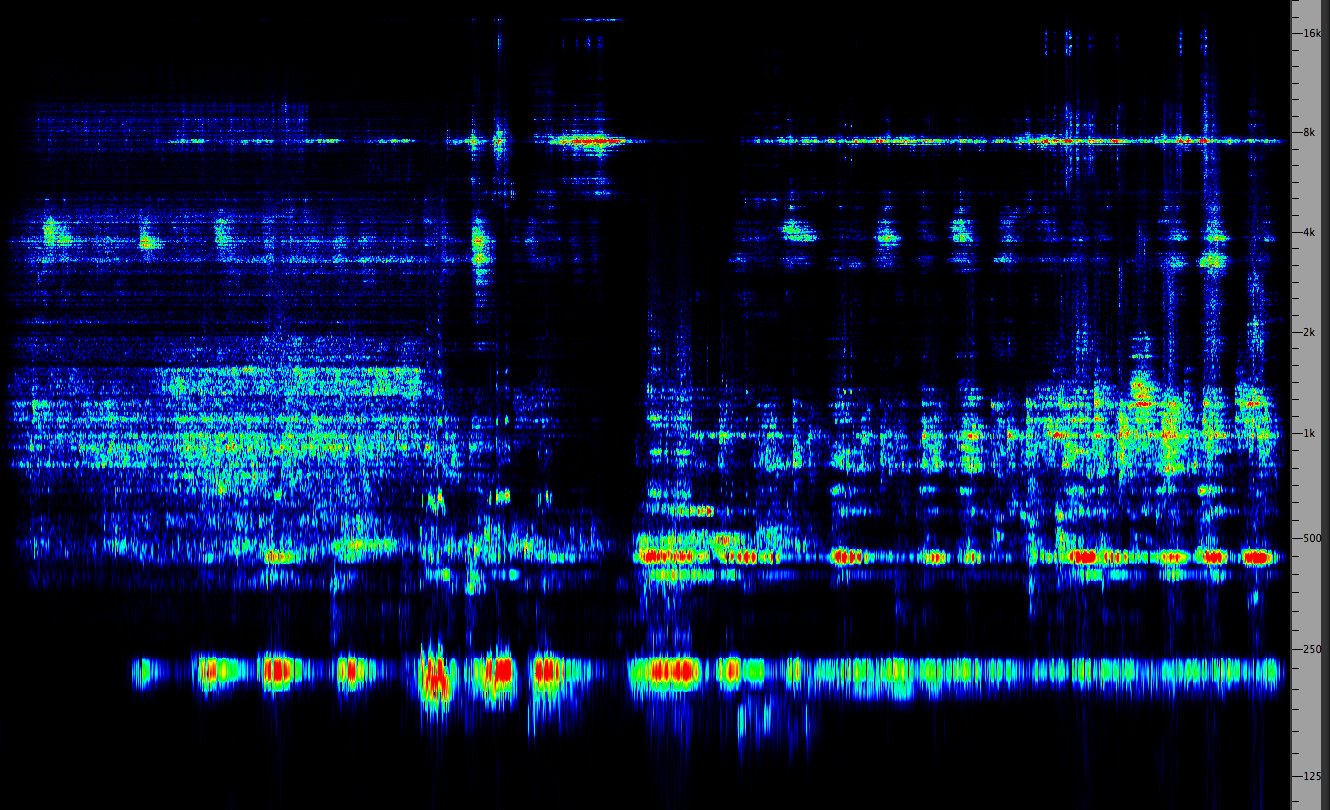
Click
to enlarge
|
The second
excerpt is from the end of that scene with the transition to
the Glass Chamber, named because of the glass elements used
in several hybrid convolutions of glass with other sounds,
and at the end of the excerpt we are at the entrance to the
underworld.
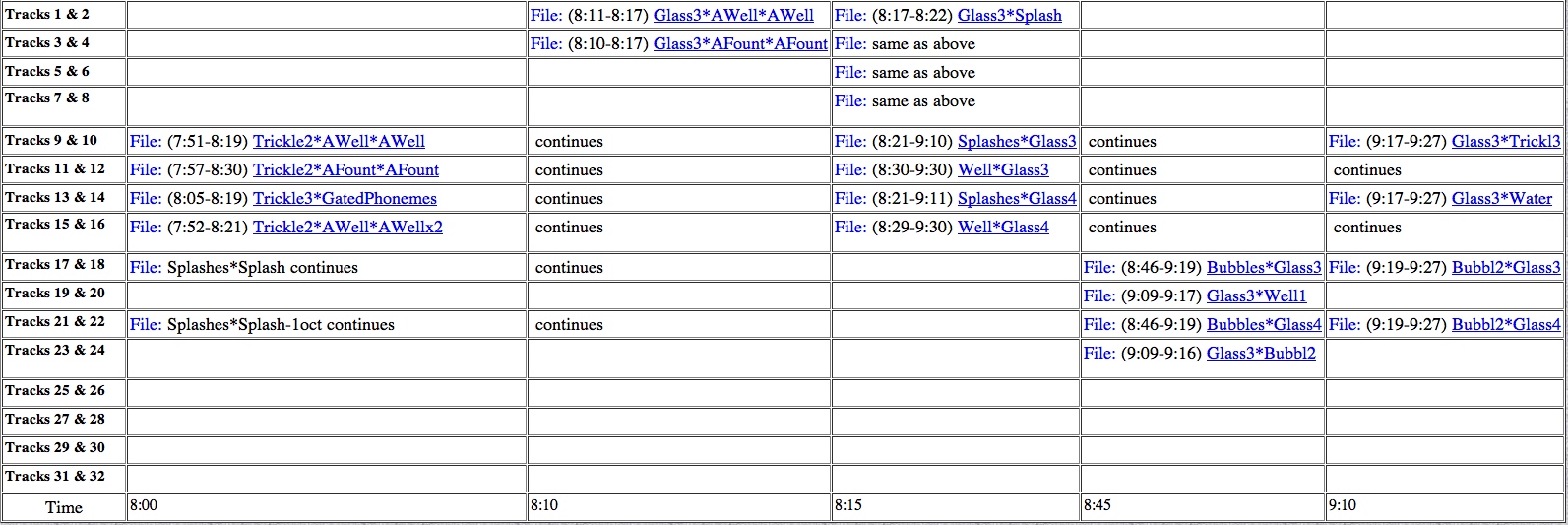
Production
score
of Chalice Well, Glass Chamber; click to
enlarge
Excerpt of Chalice Well (2009)
Glass Chamber
starting just before 8'
from The Elements and Beyond, CSR-CD
1401
|
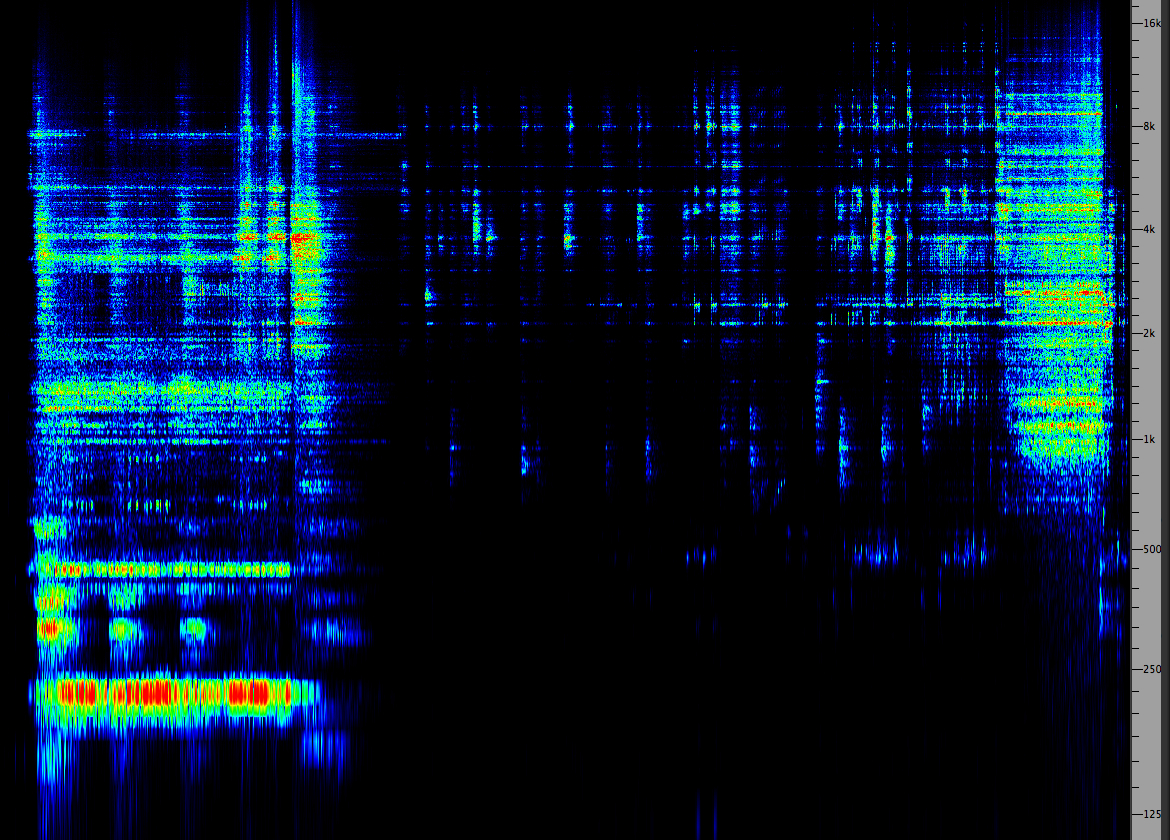
Click to enlarge
|
Extended complexity in hybrid
convolutions. My 2019 work Infinity Room
tries to take hybrid convolution a step further towards
a more abstracted perspective. The only analogy I could
think of (after the materials were already
developed) was the visual complexity and sense of
boundless space in an “Infinity Room” installation,
which has made them very popular in art galleries, but
what could we imagine would be the aural equivalent?
The resulting work creates a somewhat analogous
experience in an immersive space where a large number of
environmental sounds are refracted (i.e. convolved) with
each other and move around the listener until they trail
off into the distance. Percussive, as well as musical,
vocal and noisy sounds from various cultural sources,
combine in seemingly endless variations as we move from
mirrored room to room.
Technically, the work is based on a set of 27
acoustically rich environmental samples, each of which
is convolved with all others to create 351 stereo
hybrids (where the L/R channels are A*B and B*A). The
samples range from impulse responses in large spaces
through percussive sounds, musical and vocal excerpts,
bells, thunder and strange noises.
Each of the 351 hybridized sounds is spatialized
independently, often in trajectories around the listener
in the multi-channel space incorporating echo delays. It
is hard to imagine that any other soundscape-inspired
work has embodied this much complexity.
Just to give an impression with a stereo reduction of
this multi-channel work, here is an excerpt of three
“rooms” (or sections) of the piece, the first being a
variety of percussive sounds convolved with each other.
This is followed by a section based on a clapping sound
convolved with many other sounds, spatialized as shown
below, followed by a short clip of a traditional Korean
band convolved with various impulse responses from other
spaces.
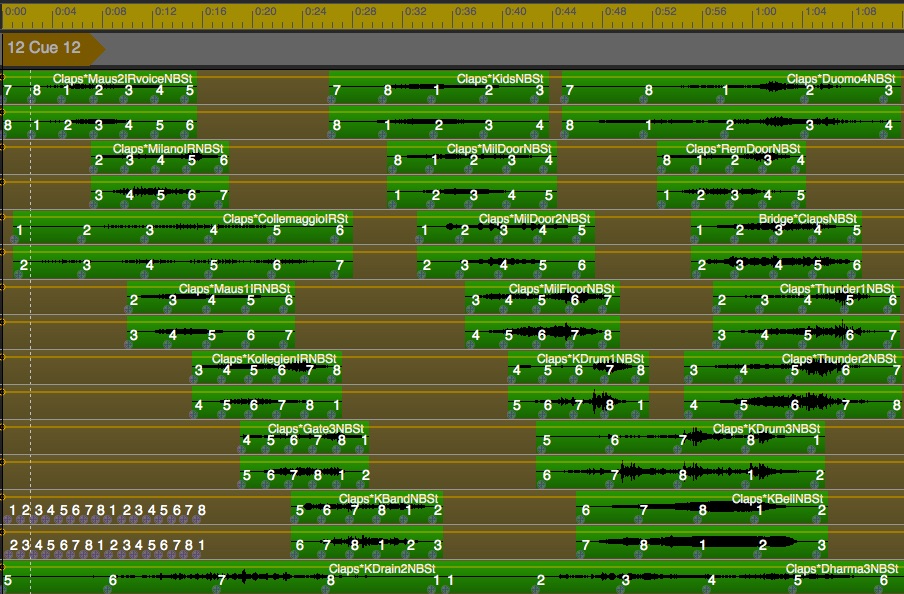
Cue from the 3rd section of Infinity Room (2019)
with 8 stereo tracks of convolved sounds; the numbers
indicate the loudspeakers in the trajectory of each sound
in the TiMax2 Soundhub spatialization software
Excerpt
of Infinity Room (2019)
|
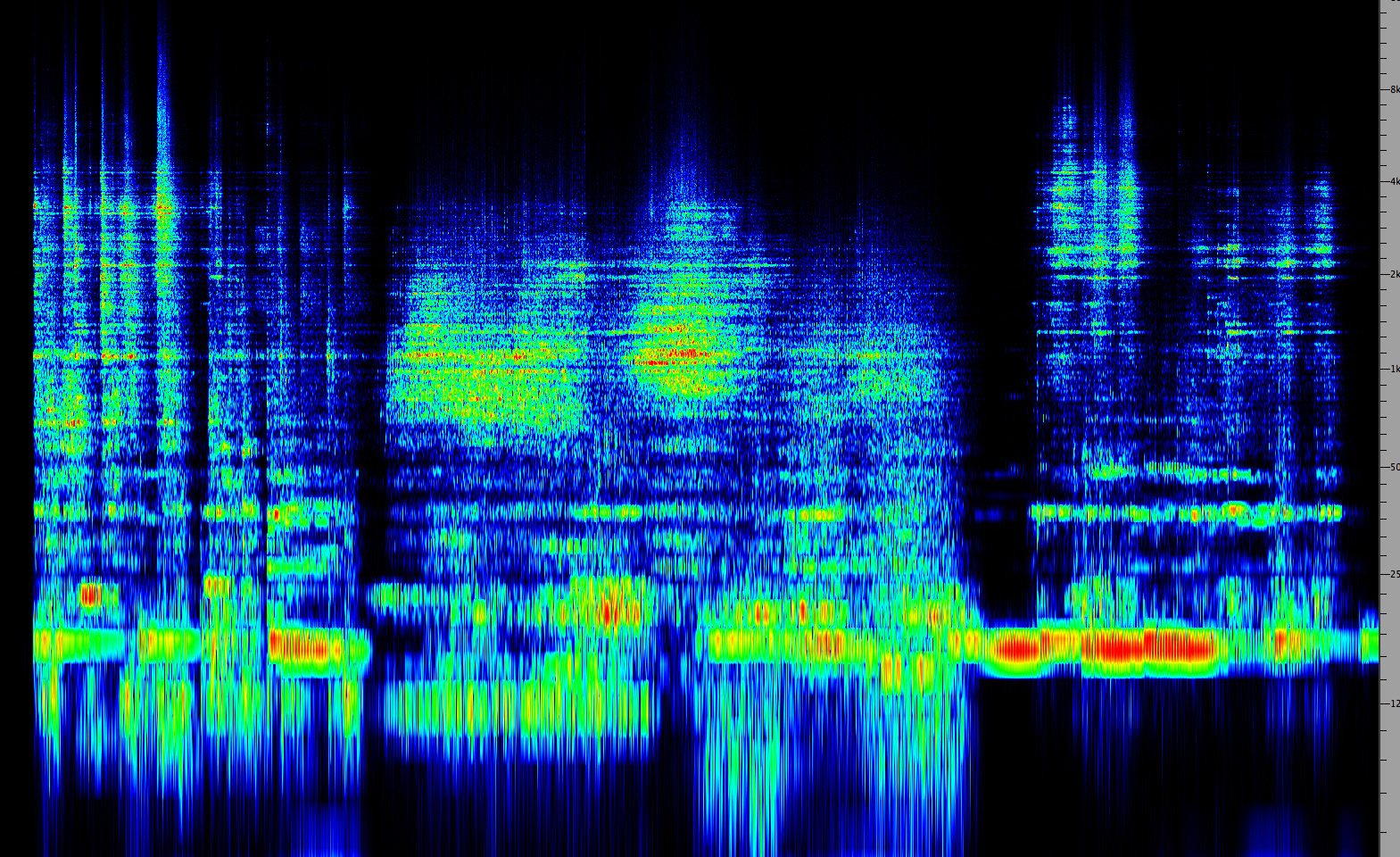
Click
to enlarge
|
home

